Xenophobia
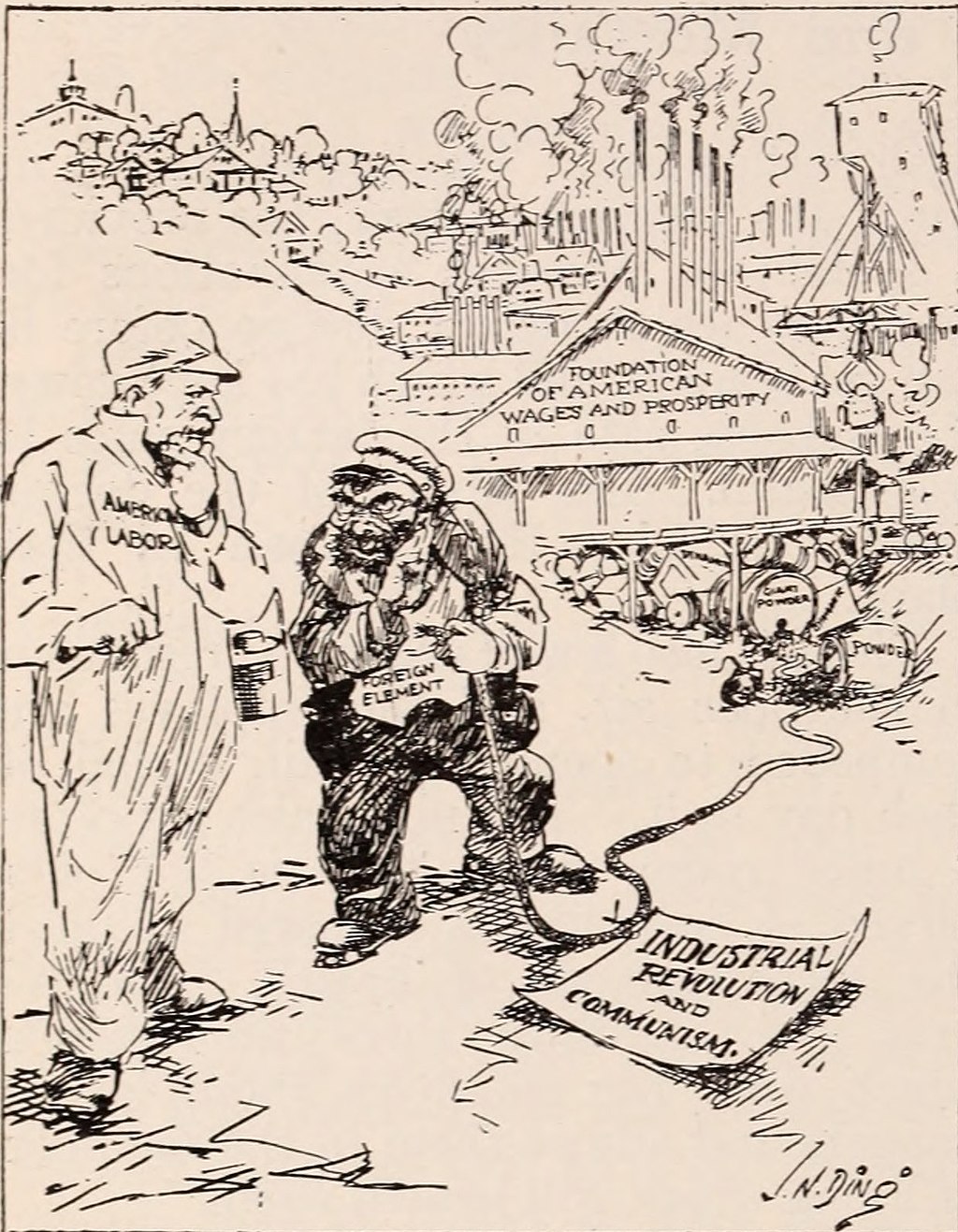
外国人嫌い
Xenophobia

★ゼノフォビアは全世界中にある。その理由は、人間は、集団生活を営むようになって長いが、
そのほとんどの時間はエスノセントリズムの状態で過ごしてきたからだ。多文化共生や多文化主義という考え方は、人類にとって新しく、また、挑戦的な生き方
なのだろうが、トランプ大統領(候補)のように、それと正反対の昔ながらの排他思想とICT-SNSによる「観念の伝染者(インフルエンサー)」のよう
に、害毒を撒き散らす新しいタイプの「新ヘイト人間」を生み出している。
| Xenophobia
(from Ancient Greek: ξένος (xénos), "strange, foreign, or alien", and
φόβος (phóbos), "fear")[1] is the fear or dislike of anything that is
perceived as being foreign or strange.[2][3][4] It is an expression
that is based on the perception that a conflict exists between an
in-group and an out-group and it may manifest itself in suspicion of
one group's activities by members of the other group, a desire to
eliminate the presence of the group that is the target of suspicion,
and fear of losing a national, ethnic, or racial identity.[5][6] |
外国人嫌い(古代ギリシャ語:ξένος
(xénos)「奇妙な、外国の、または異質な」、およびφόβος
(phóbos)「恐怖」に由来)[1]とは、外国の、または奇妙なものと認識されるものに対する恐怖や嫌悪である。[2][3][4]これは、
内集団と外集団の間に葛藤が存在するという認識に基づく表現であり、それは、他集団のメンバーによる一方の集団の活動に対する疑念、疑念の対象となってい
る集団の存在を排除したいという願望、国民、民族、人種としてのアイデンティティを失うことへの恐れとして現れることがある。[5][6] |
 A 1912 xenophobic cartoon blaming foreigners for threatening economic prosperity in the United States |
 1912年の外国人排斥を訴える風刺漫画。米国の経済的繁栄を脅かすのは外国人であると非難している。 |
| Alternative definitions A 1997 review article on xenophobia holds that it is "an element of a political struggle about who has the right to be cared for by the state and society: a fight for the collective good of the modern state."[7] According to Italian sociologist Guido Bolaffi, xenophobia can also be exhibited as an "uncritical exaltation of another culture" which is ascribed "an unreal, stereotyped and exotic quality".[5] |
代替的な定義 1997年の外国人嫌悪に関するレビュー記事では、外国人嫌悪は「国家や社会から保護される権利を誰が有するのかという政治的闘争の要素であり、近代国家 の集団的利益のための闘争である」とされている。[7] イタリアの社会学者グイド・ボラッフィによると、外国人嫌悪は「非現実的でステレオタイプ化されたエキゾチックな性質」を付与された「他文化に対する無批 判な賞賛」として表れることもある。[5] |
| History Ancient Africa In Ancient Egypt, foreigners were conceived of through a complex xenophobic discourse. Given ancient Egypt's long history, Egyptians encountered a number of different peoples. Peoples living in present-day Greece, Sudan, and Turkey, for instance, were referred to by various names in Egyptian. According to one source, "...all the names have at the end the same hieroglyphic sign– a determinative or taxogram– indicating the word-group. This is the hieroglyph for a hilly country or the desert– indicating 'foreign land' (khaset)...By contrast, Egypt (Kemet/Black land) is written with the determinative for a town. This indicates that Egyptians regarded their part of the world as cultivated, ordered and civilized, while the other countries were not."[8] This indicates an early example of a xenophobic attitude towards other peoples. In addition, ancient Egyptian hieroglyphics indicate xenophobic ideas about a necessity to conquer non-Egyptians, with Hittites in particular being referred to as "vile".[9] Ancient Europe Main article: Slavery in ancient Rome An early example of xenophobic sentiment in Western culture is the Ancient Greek denigration of foreigners as "barbarians", the belief that the Greek people and culture were superior to all other peoples and cultures, and the subsequent conclusion that barbarians were naturally meant to be enslaved.[10] Ancient Romans also held notions of superiority over other peoples.[11] such as in a speech attributed to Manius Acilius: There, as you know, there were Macedonians and Thracians and Illyrians, all most warlike nations, here Syrians and Asiatic Greeks, the most worthless peoples among mankind and born for slavery.[11] 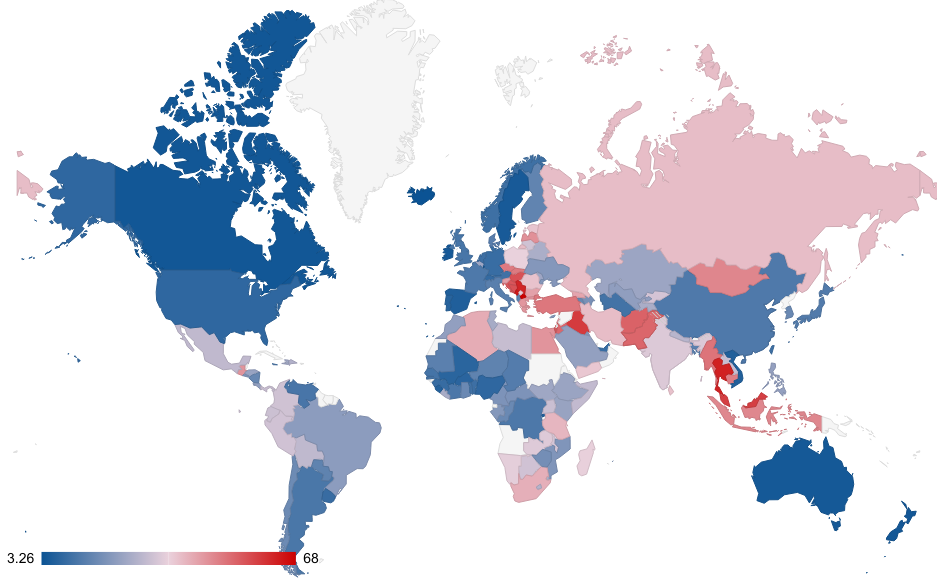 A global index of anti-immigrant xenophobia based on https://doi.org/10.1080/21565503.2022.2097097 Black Africans were considered especially exotic, and perhaps they were considered threateningly alien, so they are seldom if ever mentioned in Roman literature without some negative connotations. The historian Appian claims that the military commander Marcus Junius Brutus, before the battle of Philippi in 42BC, met an 'Ethiopian' outside the gates of his camp: his soldiers instantly hacked the man to pieces, taking his appearance for a bad omen—to the superstitious Roman, black was the colour of death."[12] COVID-19 Main article: Xenophobia and racism related to the COVID-19 pandemic The COVID-19 pandemic, which was first reported in the city of Wuhan, Hubei, China, in December 2019, has led to an increase in acts and displays of Sinophobia, as well as prejudice, xenophobia, discrimination, violence, and racism against people of East Asian and Southeast Asian descent and appearance around the world.[13][14] With the spread of the pandemic and the formation of COVID-19 hotspots, such as those in Asia, Europe, and the Americas, discrimination against people from these hotspots has been reported.[15][16][17] |
歴史 古代アフリカ 古代エジプトでは、外国人に対する複雑な排外主義的言説が存在していた。古代エジプトの長い歴史を考えると、エジプト人は数多くの異なる民族と遭遇してい た。例えば、現在のギリシャ、スーダン、トルコに住む民族は、エジプト語ではさまざまな名称で呼ばれていた。ある情報源によると、「...すべての名称の 末尾には同じヒエログリフ記号、つまり語群を示す決定記号またはタクソグラムが付けられている。これは丘陵地や砂漠を表す象形文字であり、「外国」を意味 する(khaset)...それに対して、エジプト(Kemet/黒い土地)は、町を表す象形文字で表記される。これは、エジプト人が自分たちの住む地域 を耕作され、秩序が保たれ、文明化された地域であるとみなしていたことを示している。一方、他の国々はそうではなかった。」[8] これは、他民族に対する排外主義的な態度の初期の例を示している。さらに、古代エジプトのヒエログリフは、非エジプト人を征服する必要性についての排外主 義的な考えを示しており、特にヒッタイト人は「卑しい」と表現されている。[9] 古代ヨーロッパ 詳細は「古代ローマの奴隷制」を参照 西洋文化における外国人排斥感情の初期の例としては、古代ギリシア人が外国人を「野蛮人」と蔑視したこと、ギリシア人およびギリシア文化が他のあらゆる民 族や文化よりも優れているという信念、そして、野蛮人は当然奴隷にされるべきであるという結論が挙げられる。 古代ローマ人もまた、他の民族に対する優越感を抱いていた。マニウス・アキリウスに帰せられる演説の一節を引用すると、 「ご存知のように、そこにはマケドニア人、トラキア人、イリュリア人がおり、いずれも好戦的な国民であった。また、シリア人とアジアのギリシア人もおり、 人類の中で最も価値のない民族であり、奴隷として生まれたのだ。  https://doi.org/10.1080/21565503.2022.2097097 に基づく反移民外国人嫌悪の世界的指数 黒人アフリカ人は特にエキゾチックな存在と考えられ、おそらく脅威的な異星人として見なされていたため、ローマの文学作品では否定的な意味合いを伴わずに 言及されることはほとんどなかった。歴史家のアッピアヌスは、紀元前42年のフィリッピの戦いの前に、軍司令官マルクス・ユニウス・ブルートゥスが陣営の 門の外で「エチオピア人」と出会ったと主張している。兵士たちはその男の風貌を不吉な兆しと受け取り、即座に男を切り刻んだ。迷信深いローマ人にとって、 黒は死の色であった。」[12] COVID-19 詳細は「COVID-19パンデミックに関連する外国人排斥と人種差別」を参照 2019年12月に中国湖北省武漢市で初めて報告された新型コロナウイルス感染症(COVID-19)のパンデミックは、世界中で東アジアおよび東南アジ アの血筋や外見を持つ人々に対するシノフォビア(中国恐怖症)の行為や表明の増加につながり、偏見、外国人排斥、差別、暴力、人種差別も引き起こしている 世界中で東アジアおよび東南アジアの血筋や外見を持つ人々に対する偏見、外国人嫌い、差別、暴力、人種差別が増加している。[13][14] パンデミックの拡大とアジア、ヨーロッパ、アメリカ大陸などの新型コロナウイルス感染症のホットスポットの形成に伴い、これらのホットスポットの人々に対 する差別が報告されている。[15][16][17] |
| Regional manifestations Americas Main articles: Racism in North America and Racism in South America Brazil Main articles: Racism in Brazil and Racial democracy Despite the majority of the country's population being of mixed (Pardo), African, or indigenous heritage, depictions of non-European Brazilians on the programming of most national television networks is scarce and typically relegated for musicians/their shows. In the case of telenovelas, Brazilians of darker skin tone are typically depicted as housekeepers or in positions of lower socioeconomic standing.[18][19][20] Canada Main article: Racism in Canada See also: Anti-Quebec sentiment Muslim and Sikh Canadians have faced racism and discrimination in recent years, especially since the 2001 terrorist attacks on the U.S. and the spillover effect of the United States' War on Terror.[21][22] An increase in hate crimes targeting Ontario Muslims was reported after ISIS took responsibility for the November 2015 Paris attacks.[23] A 2016 survey from The Environics Institute, which was a follow-up to a study conducted 10 years prior, found that there may be discriminating attitudes that may be a residual of the effects of the 11 September 2001 attacks in the United States.[24] A poll in 2009 by Maclean's revealed that only 28% of Canadians view Islam favourably, and only 30% viewed the Sikh religion favourably. 45% of respondents believed Islam encourages violence. In Quebec in particular, only 17% of respondents had a favourable view of Islam.[25] Colombia According to the UNHCR, by June 2019, 1.3 million of the 4 million Venezuelan refugees were in Colombia.[26] Because of their urgent situation, many migrants from Venezuela crossed the border illegally, indicating they had few opportunities to gain "access to legal and other rights or basic services and are exposed to exploitation, abuse, manipulation and a wide range of other protection risks, including racism, discrimination and xenophobia".[27] Since the start of the migrant crisis, media outlets and state officials have raised concerns about increasing discrimination against migrants in the country, especially xenophobia and violence against the migrants.[28] Guyana There have been racial tension between the Indo-Guyanese people and the Afro-Guyanese.[29][30][31] Mexico Main articles: Racism in Mexico, The Chinese in Mexico, and Chinese immigration to Mexico Racism in Mexico has a long history.[32] Historically, Mexicans with light skin tones had absolute control over dark skinned Amerindians due to the structure of the Spanish colonial caste system. When a Mexican of a darker-skinned tone marries one of a lighter skinned-tone, it is common for them say that they are " 'making the race better' (mejorando la raza)". This can be interpreted as a self-attack on their ethnicity.[33] Despite improving economic and social conditions of indigenous Mexicans, discrimination against them continues to this day and there are few laws to protect indigenous Mexicans from discrimination. Violent attacks against indigenous Mexicans are moderately common and many times go unpunished.[34] On 15 March 1911, a band of Maderista soldiers entered Torreón, Mexico, and massacred 303 Chinese and five Japanese. Historian Larissa Schwartz argues that Kang Youwei had successfully organized the prosperous Chinese businessmen there, making them a visible target for class antagonism made extreme by xenophobia.[35] The Chinese were easy to identify in northern cities and were frequent targets especially in Sonora in the 1930s. Systematic persecution resulted from economic, political, and psychological fears of the Chinese, and the government showed little interest in protecting them.[36][37] Theresa Alfaro-Velcamp argues that the Porfiriato, 1876–1910 promoted immigration from the Middle East. However the revolution of 1910–20 saw a surge in xenophobia and nationalism based on "mestizaje." The community divided into the economically prosperous Lebanese Mexicans who took pride in a distinct Lebanese-Mexican identity, while the downscale remainder often merged into the mestizo community.[38] Racism against indigenous people has been a current problem in Mexico.[39] Domestic workers, many of whom are indigenous women who have moved from rural villages to cities, often face discrimination including verbal, physical or sexual abuse.[40] Panama Further information: Afro-Panamanians Peter Szok argues that when the United States brought in large numbers of laborers from the Caribbean—called "Afro-Panamanians"—to build the Panama Canal (1905–1914), xenophobia emerged. The local elite in Panama felt its culture was threatened: they cried out, "La Patria es el Recuerdo." ("The Homeland is the Memory") and developed a Hispanophile elitist identity through an artistic literary movement known as "Hispanismo." Another result was the election of the "overtly nationalist and anti-imperialist" Arnulfo Arias as president in 1940.[41] Venezuela In Venezuela, like other South American countries, economic inequality often breaks along ethnic and racial lines.[42] A 2013 Swedish academic study stated that Venezuela was the most racist country in the Americas,[42] followed by the Dominican Republic.[42] United States Main article: Xenophobia in the United States In a 2010 report, a network of more than 300 US-based civil rights and human rights organizations stated that "Discrimination permeates all aspects of life in the United States, and it extends to all communities of color."[43] Discrimination against racial, ethnic, and religious minorities is widely acknowledged, especially in the case of [African Americans] and African Diasporic peoples in the United States], as well as other ethnic groups. Members of every major American ethnic and religious minority group have perceived discrimination in their dealings with members of other minority racial and religious groups. Philosopher Cornel West has argued that "racism is an integral element within the very fabric of American culture and society. It is embedded in the country's first collective definition, enunciated in its subsequent laws, and imbued in its dominant way of life."[44] A 2019 survey by the Pew Research Center suggested that 76% of black and Asian respondents had experienced some form of discrimination, at least from time to time.[45] Studies which have been conducted by the PNAS and Nature have found that during traffic stops, officers spoke to black men in a less respectful tone than they spoke to white men and those same studies have also found that black drivers are more likely to be pulled over and searched by police than white drivers.[46] Black people are also reportedly overrepresented as criminals in the media.[47] In 2020 the COVID-19 epidemic was often blamed on China, leading to attacks on Chinese Americans.[48] This represents a continuation of xenophobic attacks on Chinese Americans for 150 years.[49] Asia Main article: Racism in Asia Bhutan See also: Ethnic cleansing in Bhutan and Bhutanese refugees In 1991–92, Bhutan is said to have deported between 10,000 and 100,000 ethnic Nepalis (Lhotshampa). The actual number of refugees who were initially deported is debated by both sides. In March 2008, this population began a multiyear resettlement in third countries including the U.S., Canada, New Zealand, Norway, Denmark, the Netherlands and Australia.[50] At present,[when?] the United States is working towards resettling more than 60,000 of these refugees in the US in accordance with its third country settlement program.[51] Brunei Brunei law permits positive discrimination in favor of ethnic Malays.[citation needed] China Main article: Racism in China The Boxers Main article: Boxer Rebellion The Boxer Rebellion was a violent anti-foreign, anti-Christian, and anti-imperialist uprising which occurred in China between 1899 and 1901. It was led by a new group, the "Militia United in Righteousness', the group was popularly known as the Boxers because many of its members had practiced Chinese martial arts, at the time, these martial arts were popularly referred to as Chinese Boxing. After China's defeat in war by Japan in 1895, villagers in North China feared the expansion of foreign spheres of influence and resented the extension of privileges to Christian missionaries. In a severe drought, Boxer violence spread across Shandong and the North China Plain, destroying foreign property, attacking or murdering Christian missionaries and Chinese Christians. In June 1900, Boxer fighters, convinced that they were invulnerable to foreign weapons, converged on Beijing, and their slogan was "Support the Qing government and exterminate the foreigners." Diplomats, missionaries, soldiers and some Chinese Christians took refuge in the diplomatic Legation Quarter. They were besieged for 55 days by the Imperial Army of the Chinese government and the Boxers. George Makari says that the Boxers, "promoted a violent hatred of all those from other lands and made no effort to distinguish the beneficent from the rapacious ones.... They were unabashedly xenophobic."[52] The Boxers were overthrown by an Eight Nation Alliance of American, Austro-Hungarian, British, French, German, Italian, Japanese, and Russian troops—20,000 in all—that invaded China to lift the siege in August 1900. The allies imposed the Boxer Protocol in 1901, with a massive annual cash indemnity to be paid by the Chinese government. The episode generated worldwide attention and denunciation of xenophobia.[53][54] Chinese nationalism and xenophobia Historian Mary C. Wright has argued that the combination of Chinese nationalism and xenophobia had a major impact on the Chinese worldview in the first half of the 20th century. Examining the bitterness and hatred which existed towards Americans and Europeans in the decades before the Communist takeover in 1949, she argues: The crude fear of the white peril that the last imperial dynasty had been able to exploit in the Boxer Rebellion of 1900 had been submerged but not overcome, and expanding special privileges of foreigners were irritants in increasingly wide spheres of Chinese life. These fears and irritations provided a mass sounding board for what otherwise might have been rather arid denunciations of imperialists. It is well to remember that both Nationalists and Communists have struck this note.[55][56] COVID-19 In China, xenophobia against non-Chinese residents has been inflamed by the COVID-19 pandemic in mainland China, with foreigners being described as "foreign garbage" and targeted for "disposal".[57] Some black people in China were evicted from their homes by police and told to leave China within 24 hours, due to disinformation that they and other foreigners were spreading the virus.[58] Expressions of Chinese xenophobia and discriminatory practices, such as the exclusion of black customers from restaurants, were criticized by foreign governments and members of the diplomatic corps.[59][60] Hong Kong Black people in Hong Kong have experienced negative comments and instances of discrimination in the job market and on public transport.[61][62] Expats and South Asian minorities have faced increased xenophobia during the COVID-19 pandemic.[63][64] Persecution of Uighurs Main article: Persecution of Uyghurs in China Since 2017, China has come under intense international criticism for its treatment of one million Muslims (the majority of them are Uyghurs, a Turkic ethnic minority mostly in Xinjiang) who are being held in detention camps without any legal process.[65][66] Critics of the policy have described it as the Sinicization of Xinjiang and some have also called it an ethnocide or a cultural genocide.[65][67] Indonesia Main articles: Racism in Indonesia, Papua conflict, and Discrimination against Chinese Indonesians A number of discriminatory laws against Chinese Indonesians were enacted by the government of Indonesia. In 1959, President Sukarno approved PP 10/1959 that forced Chinese Indonesians to close their businesses in rural areas and relocate into urban areas. Moreover, political pressures in the 1970s and 1980s restricted the role of the Chinese Indonesian in politics, academics, and the military. As a result, they were thereafter constrained professionally to becoming entrepreneurs and professional managers in trade, manufacturing, and banking. In 1998, Indonesia riots over higher food prices and rumors of hoarding by merchants and shopkeepers often degenerated into anti-Chinese attacks.[68][69] Native Papuans in the country have faced racism,[70][71] and several reports have accused Indonesia of committing a "slow-motion genocide" in West Papua.[72][73][74][75][76] Hostility towards the LGBT community has been recently reported,[77][78] especially in Aceh.[79][80] Japan Main article: Xenophobia in Japan Japan had successfully isolated itself from the outside world, allowing anti-foreign sentiments and myths to multiply unchecked by actual observation.[81] In 2005, a United Nations report expressed concerns about racism in Japan and it also stated that the government's recognition of the depth of the problem was not total.[82][83] The author of the report, Doudou Diène (Special Rapporteur of the UN Commission on Human Rights), concluded after a nine-day investigation that racial discrimination and xenophobia in Japan primarily affected three groups: national minorities, Latin Americans of Japanese descent, mainly Japanese Brazilians, and foreigners from poor countries.[84] Surveys conducted in 2017 and 2019 have shown that 40 to nearly 50% of the foreigners who were surveyed have experienced some form of discrimination.[85][86] Another report has also noted differences in how the media and some Japanese treat visitors from the West as compared to those from East Asia, with the latter being viewed much less positively than the former.[87] Japan accepted just 16 refugees in 1999, while the United States took in 85,010 for resettlement, according to the UNHCR. New Zealand, which is 30 times smaller than Japan, accepted 1,140 refugees in 1999. Just 305 persons were recognized as refugees by Japan from 1981, when Japan ratified the UN Convention Relating to the Status of Refugees, to 2002.[88][89] Former Prime Minister Taro Aso called Japan a "one race" nation.[90] A 2019 Ipsos poll also suggested that Japanese respondents had a relatively lower sympathy for refugees compared to most other countries in the survey.[91][92] Sharon Yoon and Yuki Asahina argue that Zaitokukai, a right-wing organization, succeeded in framing Korean minorities as undeserving recipients of Japanese welfare benefits. Even as Zaitokukai declined, the perceptions of a Korean internal threat powerfully influences public fears.[93] Malaysia Main articles: Xenophobia in Malaysia and Racism in Malaysia The racial tension between the dominant poor Malay Muslims and the minority wealthier Chinese has long characterized Malaysia. It was a major factor in the separation of Singapore in 1965 to become an independent, primarily Chinese nation. Amy L. Freedman points to the electoral system, the centrality of ethnic parties, gerrymandering, and systematic discrimination against the Chinese in education and jobs as critical factors in xenophobia. Recently the goal of creating a more inclusive national identity has been emphasized.[94] In Malaysia, xenophobia occurs regardless of race. Most xenophobia is towards foreign labourers, who normally came from Indonesia, Bangladesh[95] and Africa.[96] There is also a significant degree of xenophobia towards neighbouring Singaporeans and Indonesians. South Korea Main article: Racism in South Korea Xenophobia in South Korea has been recognized by scholars and the United Nations as a widespread social problem.[97] An increase in immigration to South Korea since the 2000s catalyzed more overt expressions of racism, as well as criticism of those expressions.[97][98] Newspapers have frequently reported on and criticized discrimination against immigrants, in forms such as being paid lower than the minimum wage, having their wages withheld, unsafe work conditions, physical abuse, or general denigration.[97] After 2010, xenophobia became increasingly prevalent in the widely used social media. Jiyeon Kang reports a common pattern scapegoating dark-skinned migrants by gender, race and class. They are presented as accomplices and beneficiaries of the elite coalition allegedly taking traditional rights away from South Korean male citizens.[99] In a 2010–2014 World Values Survey, 44.2% of South Koreans reported they would not want an immigrant or foreign worker as a neighbor.[100][98] Racist attitudes are more commonly expressed towards immigrants from other Asian countries and Africa, and less so towards European and white North American immigrants who can occasionally receive what has been described as "overly kind treatment".[97][101] Related discrimination have also been reported with regards to mixed-race children, Chinese Korean, and North Korean immigrants.[101] Philippines Main article: Xenophobia in the Philippines [icon] This section is empty. You can help by adding to it. (February 2023) Thailand Main article: Racism in Thailand  Anti-Arab sign in Pattaya Beach, Thailand There are no laws within the Kingdom of Thailand which criminalize racial discrimination and the use of racist cliches. Unlike neighboring nations which were colonized, Thailand's history as an uncolonized state further shaped its existing laws.[citation needed] Anti-refugee sentiment has been significant in Thailand, with a 2016 Amnesty International survey indicating that 74% of surveyed Thais do not believe (to varying degrees) that people should be able to take refuge in other countries to escape war or persecution.[102] Middle East Further information: Xenophobia and racism in the Middle East See also: Antisemitism in the Arab world In 2008, a Pew Research Center survey found that negative views concerning Jews were most common in the three predominantly Arab nations which were polled, with 97% of Lebanese having an unfavorable opinion of Jews, 95% of Egyptians and 96% of Jordanians.[103] Egypt The Egyptian Muslim Brotherhood leader Mohammed Mahdi Akef has denounced what he called "the myth of the Holocaust" in defense of the former-Iranian president Mahmoud Ahmadinejad's denial of it.[104] In an article in October 2000 columnist Adel Hammoda alleged in the state-owned Egyptian newspaper al-Ahram that Jews make Matza from the blood of non-Jewish children (see Blood libel).[105] Mohammed Salmawy, the editor of Al-Ahram Hebdo, "defended the use of old European myths like the blood libel against Jews" in his newspapers.[106] Jordan Jordan does not allow entry to Jews who have visible signs of Judaism or possess personal religious items. The Jordanian ambassador to Israel replied to a complaint by a religious Jew who was denied entry by stating that security concerns required that travelers who are entering the Hashemite Kingdom should not do so with prayer shawls (Tallit) and phylacteries (Tefillin).[107] Jordanian authorities state that the policy is to ensure the Jewish tourists' safety.[108] In July 2009, six Breslov Hasidim were deported after attempting to enter Jordan to visit the tomb of Aaron / Sheikh Harun on Mount Hor, near Petra. The group had taken a ferry from Sinai, Egypt because they understood that Jordanian authorities were making it hard for visible Jews to enter their country from Israel.[109] Israel See also: Xenophobia in Israel, Racism in Israel, and Anti-Arabism in Israel 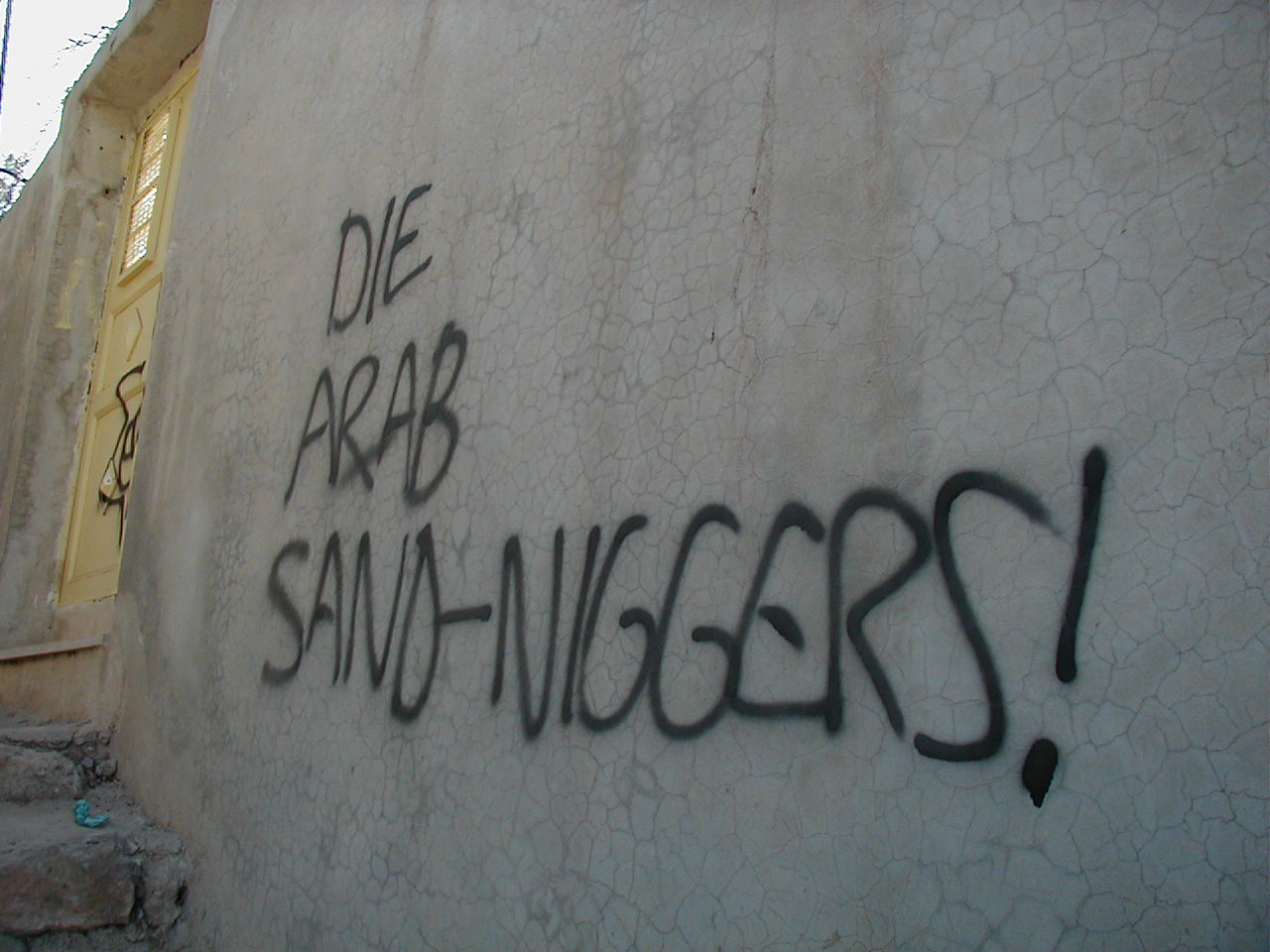 Graffiti reading "Die Arab Sand-Niggers!" reportedly sprayed by settlers on a house in Hebron[110] According to the 2004 U.S. State Department Country Reports on Human Rights Practices for Israel and the Occupied Territories, the Israeli government had done "little to reduce institutional, legal, and societal discrimination against the country's Arab citizens."[111] The 2005 US Department of State report on Israel wrote: "[T]he government generally respected the human rights of its citizens; however, there were problems in some areas, including... institutional, legal, and societal discrimination against the country's Arab citizens."[112] The 2010 U.S. State Department Country Report stated that Israeli law prohibits discrimination on the basis of race, and the Israeli government effectively enforced these prohibitions.[113] Former Likud MK and Minister of Defense Moshe Arens has criticized the treatment of minorities in Israel, saying that they did not bear the full obligation of Israeli citizenship, nor were they extended the full privileges of citizenship.[114] The Association for Civil Rights in Israel (ACRI) published reports which documented racism in Israel, and the 2007 report suggested that anti-Arab racism was increasing in the country. One analysis of the report summarized it thus: "Over two-thirds of Israeli teens believe that Arabs are less intelligent, uncultured and violent.[115][116] The Israeli government spokesman responded that the Israeli government was "committed to fighting racism whenever it raises its ugly head and is committed to full equality to all Israeli citizens, irrespective of ethnicity, creed or background, as defined by our declaration of independence".[116] Isi Leibler of the Jerusalem Center for Public affairs argues that Israeli Jews are troubled by "increasingly hostile, even treasonable outbursts by Israeli Arabs against the state" while it is at war with neighboring countries.[117] Khaled Diab of The Guardian wrote in 2012 that demonisation was a two-way street, with Palestinians in Israel reportedly holding negative stereotypes of Israelis as devious, violent, cunning and untrustworthy.[118] A 2018 poll by Pew Research Center also suggested there to be particularly widespread anti-refugee sentiment among surveyed Israelis compared to the people from other selected countries. Israeli people also have a long history of discrimination towards Palestinians[119] Kuwait In April 2020, an actress said on Kuwaiti TV that migrants should be thrown out "into the desert", amidst reported exploitation of foreign labourers in the country.[120] Reports of Sierra Leonean, Indonesian and Nepalese workers suffering abuse in Kuwait have prompted the 3 countries' governments to ban its citizens from being employed as domestic workers there.[121] Expat surveys done by InterNations have ranked the country amongst the most unfriendly for expatriates.[122][123] Lebanon Hezbollah's Al-Manar TV channel has often been accused of airing antisemitic broadcasts, accusing the Jews/Zionists of conspiring against the Arab world, and frequently airing excerpts from The Protocols of the Elders of Zion,[124][125][126] which the Encyclopædia Britannica describes as a "fraudulent document which served as a pretext and rationale for anti-Semitism in the early 20th century". In another incident, an Al-Manar commentator recently referred to "Zionist attempts to transmit AIDS to Arab countries". Al-Manar officials denied broadcasting any antisemitic incitement and they also stated that their group's position is anti-Israeli, not antisemitic. However, Hezbollah has directed strong rhetoric against both Israel and Jews, and it has cooperated in publishing and distributing outright antisemitic literature. The government of Lebanon has not criticized Hezbollah's continued broadcast of antisemitic material on television.[127] There are also substantial accounts[128] of abuses against migrant domestic workers in Lebanon, notably from Ethiopia, Bangladesh, the Philippines, Sri Lanka, Sudan, and other countries in Asia and Africa, exacerbated by the Kafala system, or "sponsorship system". Increases in abuse occurred during the COVID-19 pandemic.[129] Palestine Main article: Racism in the Palestinian territories See also: Human rights in the Palestinian territories, Antisemitism in the Arab world § Palestinian territories, Antisemitism § Palestinian territories, and Demographics of the Palestinian territories Various Palestinian organizations and individuals have been regularly accused of being antisemitic. Howard Gutman believes that much of Muslim hatred of Jews stems from the ongoing Arab–Israeli conflict and that peace would significantly reduce antisemitism.[130] Anti-US and anti-Israeli sentiment had led some Palestinians to support the 2001 September 11 attacks in New York.[131] In August 2003, senior Hamas official Dr Abd Al-Aziz Al-Rantisi wrote in the Hamas newspaper Al-Risala:[132] It is no longer a secret that the Zionists were behind the Nazis' murder of many Jews, and agreed to it, with the aim of intimidating them and forcing them to immigrate to Palestine. In August 2009, Hamas refused to allow Palestinian children to learn about the Holocaust, which it called "a lie invented by the Zionists" and referred to Holocaust education as a "war crime".[133] A 2016 Gallup International poll had roughly 74% of Palestinian respondents agreeing there was religious superiority, 78% agreeing there was racial superiority, and 76% agreeing there was cultural superiority. The percentages were among the highest out of 66 nations surveyed.[134][135] Saudi Arabia See also: Xenophobia in Saudi Arabia, Antisemitism in Saudi Arabia, and Human rights in Saudi Arabia Racism in Saudi Arabia is practiced against labor workers who are foreigners, mostly from developing countries. Asian maids who work in the country have been victims of racism and other forms of discrimination,[136][137][138][139] foreign workers have been raped, exploited, under- or unpaid, physically abused,[140] overworked and locked in their places of employment. The international organisation Human Rights Watch (HRW) describes these conditions as "near-slavery" and attributes them to "deeply rooted gender, religious, and racial discrimination".[141] In many cases the workers are unwilling to report their employers for fear of losing their jobs or further abuse.[141] There were several cases of antisemitism in Saudi Arabia and it is common within the country's religious circles. The Saudi Arabian media often attacks Jews in books, in news articles, in its Mosques and with what some describe as antisemitic satire. Saudi Arabian government officials and state religious leaders often promote the idea that Jews are conspiring to take over the entire world; as proof of their claims they publish and frequently cite The Protocols of the Elders of Zion as factual.[142][143] Europe See also: Racism in Europe, Antisemitism in Europe, and Anti-Romani sentiment  Pro-EU Czechs protest in Prague against politicians accused of pro-Russian sympathies, 17 November 2018. The sign reads: "...all Russians...go away from the Czech Republic or die!" A study that ran from 2002 to 2015 mapped the countries in Europe with the highest incidents of racial bias towards black people, based on data from 288,076 white Europeans. It used the Implicit-association test (a reaction-based psychological test designed to measure implicit racial bias). The strongest bias was found in Czech Republic, Lithuania, Belarus, Ukraine, Malta, Moldova, Bulgaria, Italy, Slovakia, and Portugal.[144] A 2017 report by the University of Oslo Center for Research on Extremism tentatively suggests that "individuals of Muslim background stand out among perpetrators of antisemitic violence in Western Europe".[145] Negative views of Muslims have varied across different parts of Europe, and Islamophobic hate crimes have been reported across the region.[146] A 2017 Chatham House poll of more than 10,000 people in 10 European countries had on average 55% agreeing that all further migration from Muslim-majority countries should be stopped, while 20% disagreed. Majority opposition was found in Poland (71%), Austria (65%), Belgium (64%), Hungary (64%), France (61%), Greece (58%), Germany (53%), and Italy (51%).[147] 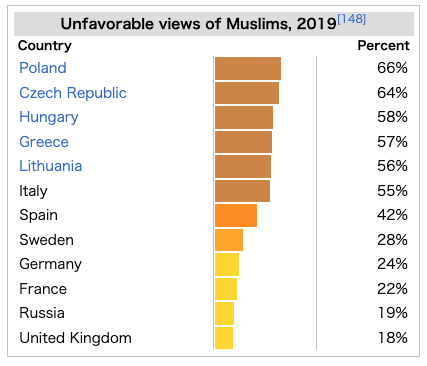 Belgium Further information: Antisemitism in Belgium, 1980 Antwerp summer camp attack, and Jewish Museum of Belgium shooting There were recorded well over a hundred antisemitic attacks in Belgium in 2009. This was a 100% increase from the year before. The perpetrators were usually young males of immigrant background from the Middle East. In 2009, the Belgian city of Antwerp, often referred to as Europe's last shtetl, experienced a surge in antisemitic violence. Bloeme Evers-Emden, an Amsterdam resident and Auschwitz survivor, was quoted in the newspaper Aftenposten in 2010: "The antisemitism now is even worse than before the Holocaust. The antisemitism has become more violent. Now they are threatening to kill us."[149] France Main article: Racism in France Further information: Antisemitism in France In 2004, France experienced rising levels of Islamic antisemitism and acts that were publicized around the world.[150][151][152] In 2006, rising levels of antisemitism were recorded in French schools. Reports related to the tensions between the children of North African Muslim immigrants and North African Jewish children.[152] The climax was reached when Ilan Halimi was tortured to death by the so-called "Barbarians gang", led by Youssouf Fofana. In 2007, over 7,000 members of the community petitioned for asylum in the United States, citing antisemitism in France.[153] In the first half of 2009, an estimated 631 recorded acts of antisemitism took place in France, more than the whole of 2008.[154] Speaking to the World Jewish Congress in December 2009, the French Interior Minister Hortefeux described the acts of antisemitism as "a poison to our republic". He also announced that he would appoint a special coordinator for fighting racism and antisemitism.[155] Germany Main article: Racism in Germany Further information: Antisemitism in 21st century Germany The period after Germany's loss of World War I led to the increased espousal of anti-Semitism and other forms of racism in the country's political discourse, for example, emotions which were initially expressed by members of the right-wing Freikorps finally culminated in the ascent of Adolf Hitler and the Nazi Party in 1933. The Nazi Party's racial policy and the Nuremberg Race Laws against Jews and other non-Aryans represented the most explicit racist policies in twentieth century Europe. These laws deprived all Jews (including half-Jews and quarter-Jews) and all other non-Aryans of German citizenship. The official title of Jews became "subjects of the state". At first, the Nuremberg Race Laws only forbade racially mixed sexual relationships and marriages between Aryans and Jews but later they were extended to "Gypsies, Negroes or their bastard offspring".[156] Such interracial relationships were known as "racial pollution" Rassenschande, and they became a criminal and punishable offence under the race laws.[156][157] The Nazi racial theory regarded Poles and other Slavic peoples as racially inferior Untermenschen. Nazi Germany's Directive No.1306 stated: "Polishness equals subhumanity. Poles, Jews and gypsies are on the same inferior level."[158] After the 1950s the steady arrival of Turkish workers led to xenophobia.[22] According to a 2012 survey, 18% of Turks in Germany believe that Jews are inferior human beings.[159][160] Hungary Anti-refugee sentiment has been strong in Hungary,[161][162] and Hungarian authorities along the border have been accused of detaining migrants under harsh conditions[163] with some reported instances of beatings and other violence from the guards.[164][165][166] Surveys from Pew Research Center have also suggested that negative views of refugees and Muslims are held by the majority of the country's locals.[167][168] As in other European countries, the Romani people faced disadvantages, including unequal treatment, discrimination, segregation and harassment. Negative stereotypes are often linked to Romani unemployment and reliance on state benefits.[169] In 2008 and 2009 nine attacks took place against Romani in Hungary, resulting in six deaths and multiple injuries. According to the Hungarian curia (supreme court), these murders were motivated by anti-Romani sentiment and sentenced the perpetrators to life imprisonment.[169] Italy Main article: Racism in Italy A new party emerged in the 1980s, Lega Nord. According to Gilda Zazzara, it started with identity-based claims and secessionist proposals for the North to break away from Southern Italy. It shifted to xenophobia and the demand that job priority be accorded to native Italian workers.[170] Anti-Roma sentiment in Italy takes the form of hostility, prejudice, discrimination or racism directed at Romani people. There's no reliable data for the total number of Roma people living in Italy, but estimates put it between 140,000 and 170,000. Many national and local political leaders engaged in rhetoric during 2007 and 2008 that maintained that the extraordinary rise in crime at the time was mainly a result of uncontrolled immigration of people of Roma origin from recent European Union member state Romania.[171] National and local leaders declared their plans to expel Roma from settlements in and around major cities and to deport illegal immigrants. The mayors of Rome and Milan signed "Security Pacts" in May 2007 that "envisaged the forced eviction of up to 10,000 Romani people."[172] According to a May 2008 poll 68% of Italians, wanted to see all of the country's approximately 150,000 Gypsies, many of them Italian citizens, expelled.[173] The survey, published as mobs in Naples burned down Gypsy camps that month, revealed that the majority also wanted all Gypsy camps in Italy to be demolished.[173] Netherlands Further information: Antisemitism in the Netherlands The first example for xenophobic riot in the Netherlands were the riots in Afrikaanderwijk, in which the houses of Turkish people were attacked and windows were smashed.[174] In early 2012 the Dutch right-wing Party for Freedom established an anti-Slavic (predominantly anti-Polish) and anti-Romani website, where native Dutch people could air their frustration about losing their job because of cheaper workers from Poland, Bulgaria, Romania and other non-Germanic Central and Eastern European countries. This led to commentaries involving hate speech and other racial prejudice mainly against Poles and Roma, but also aimed at other Central and Eastern European ethnic groups.[175] According to a 2015 report by the OECD and EU Commission, 37% of young people born in the country with immigrant parents say they had experienced discrimination in their lives.[176] In the Netherlands, antisemitic incidents, from verbal abuse to violence, are reported, allegedly connected with Islamic youth, mostly boys of Moroccan descent. A phrase made popular during football matches against the so-called Jewish football club Ajax has been adopted by Muslim youth and is frequently heard at pro-Palestinian demonstrations: "Hamas, Hamas, Jews to the gas!" According to the Centre for Information and Documentation on Israel, a pro-Israel lobby group in the Netherlands, in 2009, the number of anti-Semitic incidents in Amsterdam, the city that is home to most of the approximately 40,000 Dutch Jews, doubled compared to 2008.[177] Norway Further information: Antisemitism in Norway In 2010, the Norwegian Broadcasting Corporation after one year of research, revealed that antisemitism was common among Norwegian Muslims. Teachers at schools with large shares of Muslims revealed that Muslim students often "praise or admire Adolf Hitler for his killing of Jews", that "Jew-hate is legitimate within vast groups of Muslim students," and "Muslims laugh or command [teachers] to stop when trying to educate about the Holocaust." Additionally that "while some students might protest when some express support for terrorism, none object when students express hate of Jews" and that it says in "the Quran that you shall kill Jews, all true Muslims hate Jews." Most of these students were said to be born and raised in Norway. One Jewish father also told that his child after school had been taken by a Muslim mob (though managed to escape), reportedly "to be taken out to the forest and hanged because he was a Jew".[178] Russia Main article: Xenophobia in Russia Further information: History of the Jews in the Soviet Union and History of the Jews in Russia 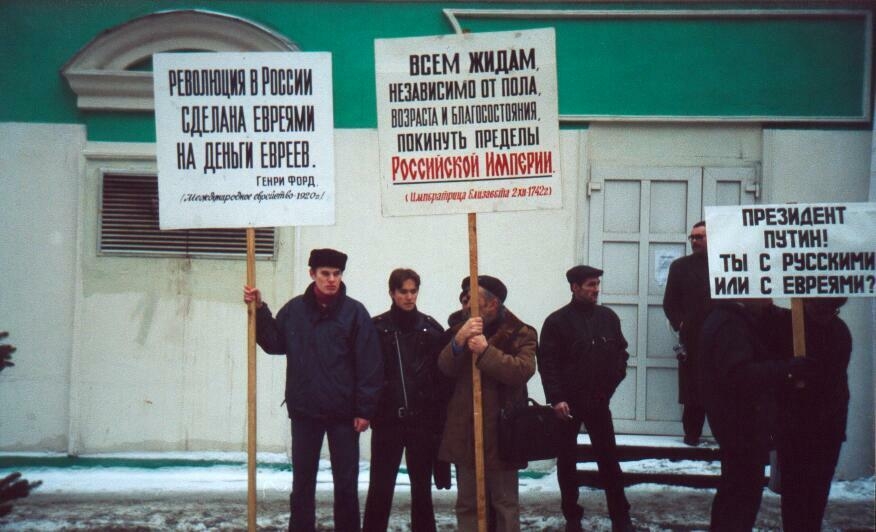 A demonstration in Russia. The antisemitic slogans cite Henry Ford and Empress Elizabeth. Lien Verpoest explores the era of the Napoleonic wars to identify the formation of conservative ideas ranging from traditionalism to ardent patriotism and xenophobia.[179] Conservatives generally controlled Russia in the 19th century, and imposed xenophobia in education and the academy. In the late 19th century, especially after nationalistic uprisings in Poland in the 1860s, the government displayed xenophobia in its hostility toward ethnic minorities that did not speak Russian. The decision was to reduce the use of other languages, and insist on Russification.[180] By the beginning of the 20th century, most European Jews lived in the so-called Pale of Settlement, the Western frontier of the Russian Empire consisting generally of the modern-day countries of Poland, Lithuania, Belarus and neighboring regions. Many pogroms accompanied the Revolution of 1917 and the ensuing Russian Civil War, an estimated 70,000 to 250,000 civilian Jews were killed in the atrocities throughout the former Russian Empire; the number of Jewish orphans exceeded 300,000.[181][182] During the civil war era (1917–1922) both the Bolsheviks and the Whites employed nationalism and xenophobia as weapons to delegitimise the opposition.[183] After World War II official national policy was to bring in students from Communist countries in East Europe and Asia for advanced training in Communist leadership roles. These students encountered severe xenophobia on campus. They survived by sticking together, but developed a hostility toward the Soviet leadership.[184] Even after the fall of Communism foreign students faced hostility on campus.[185] In the 2000s, "skinheads" were especially visible in attacking anything foreign.[186] Racism against both the Russian citizens (peoples of the Caucasus, indigenous peoples of Siberia and Russian Far East, etc.) and non-Russian citizens of Africans, Central Asians, East Asians (Vietnamese, Chinese, etc.) and Europeans (Ukrainians, etc.) became a significant factor.[187] Using surveys from 1996, 2004, and 2012, Hannah S. Chapman, et al. reports a steady increase in Russians' negative attitudes toward seven outgroups. Muscovites especially became more xenophobic.[188] In 2016, Radio Free Europe/Radio Liberty reported that "Researchers who track xenophobia in Russia have recorded an "impressive" decrease in hate crimes as the authorities appear to have stepped up pressure on far-right groups".[189] David Barry uses surveys to investigate the particularistic and xenophobic belief that all citizens should join Russia's dominant Orthodox religion. It is widespread among ethnic Russians and is increasing.[190] A 2016 GlobeScan/BBC World Service poll found that 79% of Russian respondents disapproved of accepting Syrian refugees, the highest percentage out of 18 countries surveyed.[191][192] Sweden Further information: Antisemitism in Sweden A government study in 2006 estimated that 5% of the total adult population and 39% of adult Muslims "harbour systematic antisemitic views".[193] The former prime minister Göran Persson described these results as "surprising and terrifying". However, the rabbi of Stockholm's Orthodox Jewish community, Meir Horden, said, "It's not true to say that the Swedes are antisemitic. Some of them are hostile to Israel because they support the weak side, which they perceive the Palestinians to be."[194] In March 2010, Fredrik Sieradzk told Die Presse, an Austrian Internet publication, that Jews are being "harassed and physically attacked" by "people from the Middle East", although he added that only a small number of Malmö's 40,000 Muslims "exhibit hatred of Jews". Sieradzk also stated that approximately 30 Jewish families have emigrated from Malmö to Israel in the past year, specifically to escape from harassment. Also in March, the Swedish newspaper Skånska Dagbladet reported that attacks on Jews in Malmö totaled 79 in 2009, about twice as many as the previous year, according to police statistics.[195] In December 2010, the Jewish human rights organization Simon Wiesenthal Center issued a travel advisory concerning Sweden, advising Jews to express "extreme caution" when visiting the southern parts of the country due to an increase in verbal and physical harassment of Jewish citizens by Muslims in the city of Malmö.[196] Ukraine Main article: Racism and discrimination in Ukraine Israel's Antisemitism Report for 2017 stated that "A striking exception in the trend of decrease in antisemitic incidents in Eastern Europe was Ukraine, where the number of recorded antisemitic attacks was doubled from last year and surpassed the tally for all the incidents reported throughout the entire region combined."[197] Ukrainian state historian, Vladimir Vyatrovich dismissed the Israeli report as anti-Ukrainian propaganda and a researcher of antisemitism from Ukraine, Vyacheslav Likhachev said the Israeli report was flawed and amateurish.[197] 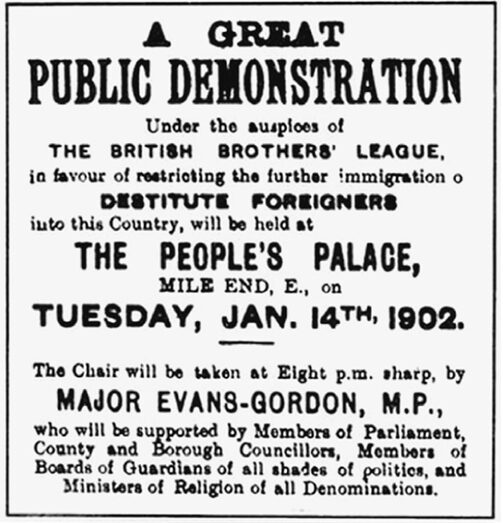 1902 rally in London England against Destitute Foreigners United Kingdom See also: Racism in the United Kingdom and Islamophobia in the United Kingdom The extent and the targets of xenophobic attitudes in the United Kingdom have varied over time. It has resulted in cases of discrimination, riots and racially motivated murders. Racism and Xenophobia were mitigated by the attitudes and norms of the British class system during the 19th century, in which race and nationality mattered less than social distinction: a black African tribal chief was unquestionably superior to a white English costermonger.[198] Use of the word "racism" became more widespread after 1936, although the term "race hatred" was used in the late 1920s by sociologist Frederick Hertz. Laws, including the Race Relations Act 1965, were passed in the 1960s that specifically prohibited racial discrimination.[199] At the 1517 Evil May Day riots in London, protestors attacked the prominence of foreigners in London wool and cloth businesses;[200][201] historians have called the event xenophobic.[200][202] Bernard Porter argues that Anti-black and anti-Indian themes waxed strong in the late 19th century, not only because of racism but also because of rebellious episodes in the British Empire in Africa and India, empire.[203] Xenophobia in popular literature targeted Germans in the early 20th centuries, based on fears of militarism and espionage.[204] According to scholar Julia Lovell, there has been a history of sinophobia dating back to the early 20th century, propagated by writers like Charles Dickens, which has endured to the present day with current media depictions of China.[205] Racism has been observed as having a correlation between factors such as levels of unemployment and immigration in an area. Some studies suggest Brexit led to a rise in racist incidents, where locals became hostile to foreigners.[206] Studies published in 2014 and 2015 claimed racism was on the rise in the UK, with more than one third of those polled admitting they were racially prejudiced.[207][needs update] However a 2019 EU survey, Being Black in the EU, ranked the UK as the least racist in the 12 Western European countries surveyed.[208] A 2016 BBC poll found increased hardening attitudes towards refugees from Syria and Libya, with 41% of British respondents saying the UK should accept fewer refugees compared to 24% saying it should accept more.[209] Sectarianism between Ulster Protestants and Irish Catholics in Northern Ireland has been called a form of racism by some international bodies.[210] It has resulted in widespread discrimination, segregation and serious violence, especially during partition and the Troubles. In recent years the intense debates over Brexit has increased xenophobia in London, especially against French living in the city.[211] Recent migrant crossings of the English Channel have also exacerbated xenophobic and racist attitudes.[citation needed] Africa Further information: Slavery in modern Africa Ivory Coast In the past recent years, Ivory Coast has seen a resurgence in ethnic tribal hatred and religious intolerance. In addition to the many victims among the various tribes of the northern and southern regions of the country that have perished in the ongoing conflict, white foreigners residing or visiting Ivory Coast have also been subjected to violent attacks. According to a report by Human Rights Watch, the Ivory Coast government is guilty of fanning ethnic hatred for its own political ends.[212] In 2004, the Young Patriots of Abidjan, a strongly nationalist organisation, rallied by the state media, plundered possessions of foreign nationals in Abidjan. Calls for violence against whites and non-Ivorians were broadcast on national radio and TV after the Young Patriots seized control of its offices. Rapes, beatings, and murders of persons of European and Lebanese descent followed. Thousands of expatriates and white or ethnic Lebanese Ivorians fled the country. The attacks drew international condemnation.[213][214] Mauritania Main article: Slavery in Mauritania Slavery in Mauritania persists despite its abolition in 1980 and mostly affects the descendants of black Africans abducted into slavery who now live in Mauritania as "black Moors" or haratin and who partially still serve the "white Moors", or bidhan, as slaves. The practice of slavery in Mauritania is most dominant within the traditional upper class of the Moors. For centuries, the haratin lower class, mostly poor black Africans living in rural areas, have been considered natural slaves by these Moors. Social attitudes have changed among most urban Moors, but in rural areas, the ancient divide remains.[215] Niger In October 2006, Niger announced that it would deport to Chad the "Diffa Arabs", Arabs living in the Diffa region of eastern Niger.[216] Their population numbered about 150,000.[217] While the government was rounding up Arabs in preparation for the deportation, two girls died, reportedly after fleeing government forces, and three women suffered miscarriages. Niger's government eventually suspended their controversial decision to deport the Arabs.[218][219] South Africa Main article: Xenophobia in South Africa 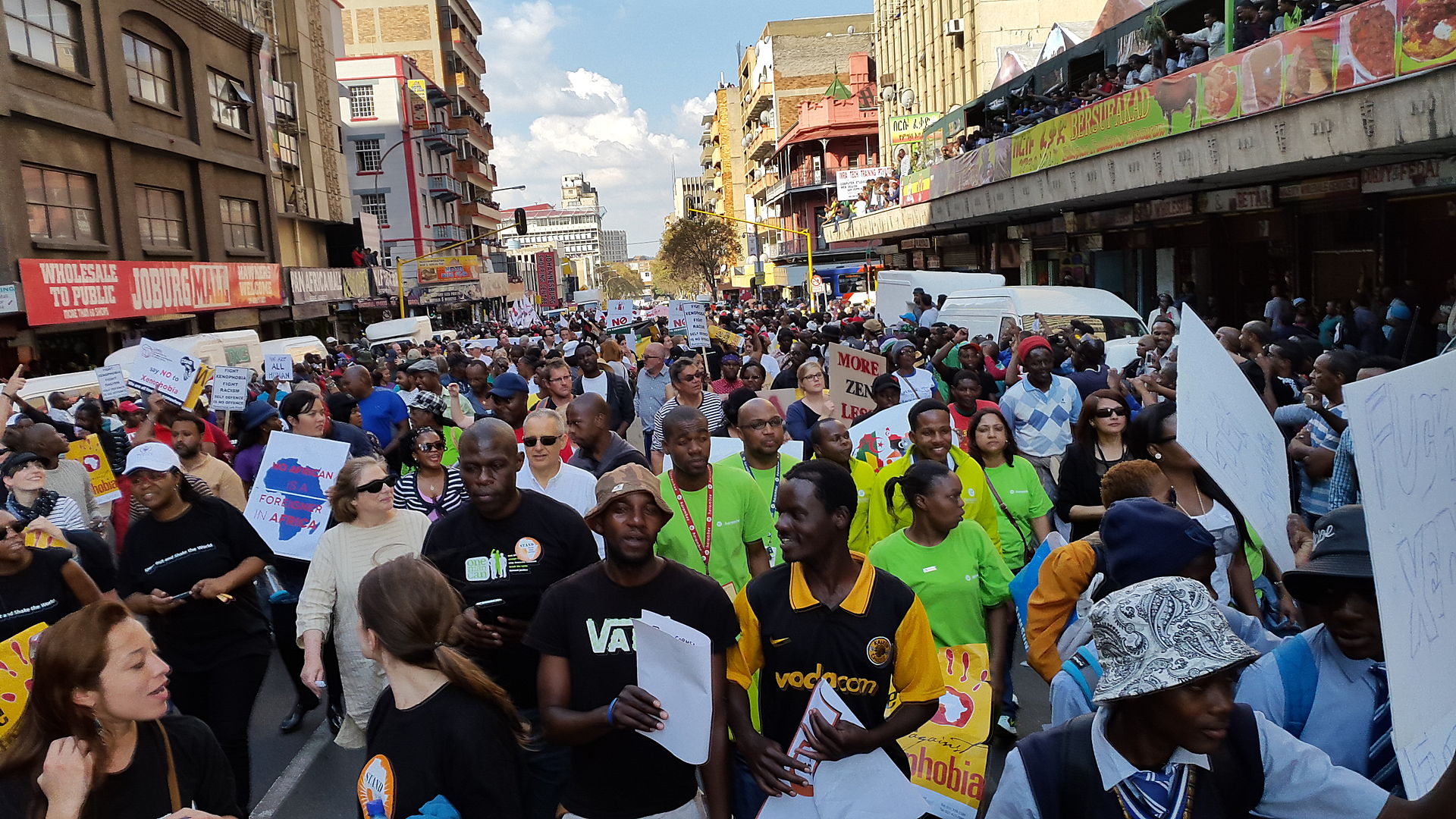 March against xenophobia in South Africa, Johannesburg, 23 April 2015 Xenophobia in South Africa has been present in both the apartheid and post–apartheid eras. Hostility between the British and Boers exacerbated by the Second Boer War led to rebellion by poor Afrikaners who looted British-owned shops.[220] South Africa also passed numerous acts intended to keep out Indians, such as the Immigrants Regulation Act of 1913, which provided for the exclusion of "undesirables", a group of people that included Indians. This effectively halted Indian immigration. The Township Franchise Ordinance of 1924 was intended to "deprive Indians of municipal franchise".[221] Xenophobic attitudes toward the Chinese have also been present, sometimes in the form of robberies or hijackings,[222] and a hate speech case in 2018 was put to court the year later with 11 offenders on trial.[223] In 1994 and 1995, gangs of armed youth destroyed the homes of foreign nationals living in Johannesburg, demanding that the police work to repatriate them to their home countries.[224] In 2008, a widely documented spate of xenophobic attacks occurred in Johannesburg.[225][226][227] It is estimated that tens of thousands of migrants were displaced; property, businesses and homes were widely looted.[228] The death toll after the attack stood at 56.[224] In 2015, another widely documented series of xenophobic attacks occurred in South Africa, mostly against migrant Zimbabweans.[229] This followed remarks by Zulu King Goodwill Zwelithini kaBhekuzulu stating that the migrants should "pack their bags and leave".[224][230] As of 20 April 2015, 7 people had died and more than 2000 foreigners had been displaced.[229] Following the riots and murders of other Africans from 2008 and 2015, violence again broke out in 2019.[231] Sudan Main article: Racism in Sudan See also: War in Darfur, South Sudan, and Slavery in Sudan In the Sudan, black African captives in the civil war were often enslaved, and female prisoners were often abused sexually,[232] with their Arab captors claiming that Islamic law grants them permission.[233] According to CBS News, slaves have been sold for US$50 apiece.[234] In September 2000, the U.S. State Department alleged that "the Sudanese government's support of slavery and its continued military action which has resulted in numerous deaths are due in part to the victims' religious beliefs."[235] Jok Madut Jok, professor of history at Loyola Marymount University, states that the abduction of women and children of the south is slavery by any definition. The government of Sudan insists that the whole matter is no more than the traditional tribal feuding over resources.[236] Uganda Main article: Expulsion of Asians from Uganda Former British colonies in Sub-Saharan Africa have many citizens of South Asian descent. They were brought by the British Empire from British India to do clerical work in imperial service.[237] The most prominent case of anti-Indian racism was the ethnic cleansing of the Indian (called Asian) minority in Uganda by the strongman dictator and human rights violator Idi Amin.[237] Oceania Australia Main article: Racism in Australia 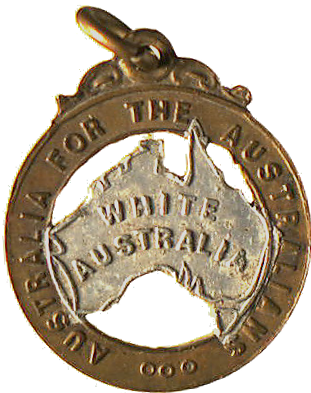 This badge from 1910 was produced by the Australian Natives' Association, comprising Australian-born whites.[238][239] The Immigration Restriction Act 1901 (White Australia policy) effectively barred people of non-European descent from immigrating to Australia.[240] There was never any specific policy titled as such, but the term was invented later to encapsulate a collection of policies that were designed to exclude people from Asia (particularly China) and the Pacific Islands (particularly Melanesia) from immigrating to Australia.[241] The Menzies and Holt governments effectively dismantled the policies between 1949 and 1966 and the Whitlam government passed laws to ensure that race would be totally disregarded as a component for immigration to Australia in 1973.[242] The 2005 Cronulla riots were a series of race riots and outbreaks of mob violence in Sydney's southern suburb Cronulla which resulted from strained relations between Anglo-Celtic and (predominantly Muslim) Lebanese Australians. Travel warnings for Australia were issued by some countries but were later removed.[243] In December 2005, a fight broke out between a group of volunteer surf lifesavers and Lebanese youth. These incidents were considered to be a key factor in a racially motivated confrontation the following weekend.[244] Violence spread to other southern suburbs of Sydney, where more assaults occurred, including two stabbings and attacks on ambulances and police officers.[245] On 30 May 2009, Indian students protested against what they claimed were racist attacks, blocking streets in central Melbourne. Thousands of students gathered outside the Royal Melbourne Hospital where one of the victims was admitted.[246] In light of this event, the Australian Government started a Helpline for Indian students to report such incidents.[247] The United Nations High Commissioner for Human Rights, Navi Pillay, termed these attacks "disturbing" and called for Australia to investigate the matters further.[248] |
地域別の現象 南北アメリカ 主な記事:北アメリカの人種主義、南アメリカの人種主義 ブラジル 主な記事:ブラジルの人種主義、人種的民主主義 国民の大半が混血(パード)、アフリカ系、あるいは先住民の血筋であるにもかかわらず、ほとんどの全国ネットのテレビ局の番組で、非ヨーロッパ系ブラジル 人が取り上げられることは少なく、通常はミュージシャンやその番組に追いやられている。 テレノベラの場合、色黒のブラジル人は通常、家政婦や社会的経済的地位の低い役として描かれることが多い。 カナダ 詳細は「カナダの人種差別」を参照 関連項目:反ケベック感情 近年、イスラム教徒とシク教徒のカナダ人は人種差別と差別を受けており、特に2001年のアメリカ同時多発テロ事件と、アメリカ同時多発テロ事件に端を発 する対テロ戦争の影響が大きい。[21][22] 2015年11月のパリ同時多発テロ事件の犯行声明をISISが発表した後、オンタリオ州のイスラム教徒を標的とした憎悪犯罪が増加したことが報告されて いる。[23] 10年前に実施された調査の追跡調査として、2016年に実施されたThe Environics Instituteの調査では、2001年9月11日の米国同時多発テロ事件の影響が残っている可能性がある差別的な態度が存在することが明らかになった 2009年の『Maclean's』誌の世論調査では、イスラム教に対して好意的な見方をしているカナダ人はわずか28%であり、シク教に対して好意的な 見方をしているカナダ人は30%に過ぎなかった。回答者の45%は、イスラム教は暴力を助長すると考えていた。特にケベック州では、イスラム教に対して好 意的な見方をしている回答者はわずか17%であった。 コロンビア 国連難民高等弁務官事務所(UNHCR)によると、2019年6月までに、400万人のベネズエラ難民のうち130万人がコロンビアにいた。[26] 彼らの緊急事態のため、ベネズエラからの多くの移民が不法に国境を越え、彼らが「法的およびその他の権利や基本的なサービスへのアクセスを得る機会がほと んどないこと、 搾取、虐待、操作、および人種差別、差別、外国人嫌悪を含む幅広い保護リスクにさらされている」ことを示している。[27] 移民危機が始まって以来、メディアや政府関係者は、国内における移民に対する差別が増加していること、特に外国人嫌悪や移民に対する暴力について懸念を表 明している。[28] ガイアナ インド系ガイアナ人とアフリカ系ガイアナ人の間で人種的緊張が生じている。[29][30][31] メキシコ 詳細は「メキシコにおける人種差別」、「メキシコにおける中国人」、および「メキシコへの中国人の移民」を参照 メキシコにおける人種差別には長い歴史がある。[32] 歴史的に、スペイン植民地時代のカースト制度の構造により、肌の色が明るいメキシコ人が、肌の色が暗いアメリカンインディアンを完全に支配していた。より 浅黒い肌のメキシコ人がより浅黒い肌のメキシコ人と結婚する場合、「人種を向上させる(mejorando la raza)」と言うのが一般的である。これは、自分たちの民族に対する攻撃と解釈することもできる。[33] 先住メキシコ人の経済的・社会的状況は改善しているにもかかわらず、彼らに対する差別は現在も続いており、先住メキシコ人を差別から守る法律はほとんどな い。メキシコ先住民に対する暴力的な攻撃はそれなりに多く、多くの場合、処罰されないままである。 1911年3月15日、マデリス党の兵士の一団がメキシコのトルーニャに入城し、中国人303人と日本人5人を虐殺した。歴史家のラリッサ・シュワルツ は、康有為が現地の裕福な中国人実業家たちをうまく組織し、外国人嫌悪によって極端化された階級対立の明白な標的となっていたと主張している。 中国人は北部の都市では容易に識別でき、特に1930年代のソノラでは頻繁に標的とされた。中国人に対する経済的、政治的、心理的な恐怖から、組織的な迫 害が起こり、政府は彼らを守ることにほとんど関心を示さなかった。 テレサ・アルファロ=ヴェルカンプは、1876年から1910年のポルフィリオ政権は中東からの移民を促進したと主張している。しかし、1910年から 1920年の革命では、外国人嫌悪と「メスティソ」に基づく民族主義が急増した。コミュニティは、レバノン系メキシコ人の経済的に豊かな人々で、レバノン 系メキシコ人としての独自なアイデンティティに誇りを持つ人々と、経済的に恵まれない人々で、後者はしばしばメスティソのコミュニティに吸収された。 先住民に対する人種主義は、メキシコにおける現在の問題である。[39] 多くの場合、農村から都市に移住した先住民の女性である家事労働者は、言葉による虐待、身体的虐待、性的虐待を含む差別を受けている。[40] パナマ 詳細情報:アフリカ系パナマ人 ピーター・ソクは、米国がパナマ運河建設(1905年~1914年)のためにカリブ海地域から多数の労働者(「アフリカ系パナマ人」と呼ばれる)を連れて きた際に、外国人排斥主義が生まれたと主張している。パナマの地元エリート層は自国の文化が脅かされていると感じ、「祖国は記憶である」と叫び、「ヒスパ ニズム」として知られる芸術・文学運動を通じてヒスパニック愛好のエリート意識を育んだ。その結果、1940年には「あからさまな民族主義者で反帝国主義 者」であるアルヌルフォ・アリアスが大統領に選出された。[41] ベネズエラ ベネズエラでは、他の南米諸国と同様に、経済的不平等がしばしば民族や人種の境界線に沿って発生している。2013年のスウェーデンの学術研究では、ベネ ズエラはアメリカ大陸で最も人種差別的な国であり、ドミニカ共和国がそれに続くと述べている。 アメリカ合衆国 詳細は「アメリカ合衆国の外国人排斥」を参照 2010年の報告書では、米国を拠点とする300以上の市民権および人権擁護団体のネットワークが、「差別は米国の生活のあらゆる側面に浸透しており、有 色人種のコミュニティ全体に広がっている」と述べている[43]。人種的、民族的、宗教的マイノリティに対する差別は広く認識されており、特に米国におけ るアフリカ系アメリカ人やアフリカ系ディアスポラの人々、およびその他の民族集団の場合に顕著である。 米国の主要な民族・宗教的マイノリティ集団のメンバーは、他のマイノリティの民族・宗教集団のメンバーとの関わりにおいて、差別を認識している。哲学者の コルネル・ウェストは、「人種主義は、米国の文化と社会の織りなすものに不可欠な要素である。それは、その後の法律で明確に述べられた、この国の最初の集 団的定義に組み込まれており、支配的な生活様式に浸透している」と主張している。 2019年のピュー研究所の調査では、黒人とアジア人の回答者の76%が、少なくとも時折、何らかの差別を経験していることが示唆された。[45] PNASとNatureが実施した研究では、交通違反の取り締まり中に、警官が黒人男性に対して白人男性に話すよりも敬意に欠ける口調で話していたことが 判明した。また、これらの研究では、黒人ドライバーは 白人のドライバーよりも警察に停車させられ、検査される可能性が高いことが分かっている。[46] また、黒人はメディアにおいて犯罪者として過剰に描写されていると報告されている。[47] 2020年には、新型コロナウイルス感染症の流行がしばしば中国に責任があるとされ、中国系アメリカ人に対する攻撃につながった。[48] これは、150年にわたる中国系アメリカ人に対する外国人排斥的攻撃の継続を表している。[49] アジア 詳細は「アジアにおける人種主義」を参照 ブータン 関連項目:ブータンにおける民族浄化、ブータン難民 1991年から1992年にかけて、ブータンは1万人から10万人のネパール系民族(ロツシャンパ)を国外追放したと言われている。当初国外追放された難 民の実際の人数については、双方で議論されている。2008年3月、この集団はアメリカ、カナダ、ニュージーランド、ノルウェー、デンマーク、オランダ、 オーストラリアを含む第三国への数年にわたる再定住を開始した。[50] 現在、[いつ?] アメリカ合衆国は第三国定住プログラムに従い、これらの難民のうち6万人以上をアメリカ国内に再定住させるべく取り組んでいる。[51] ブルネイ ブルネイの法律はマレー系住民を優遇する積極的差別を認めている。 中国 詳細は「中国の人種主義」を参照 義和団 詳細は「義和団の乱」を参照 義和団の乱は、1899年から1901年にかけて中国で発生した、外国人、キリスト教、帝国主義に対する暴力的な反乱である。義和団」と呼ばれるように なった。この集団は、当時、中国武術が一般的に「中国ボクシング」と呼ばれていたことから、そのメンバーの多くが中国武術を実践していたため、一般に義和 団として知られていた。1895年の日本による中国敗戦後、華北の村人たちは外国勢力の拡大を恐れ、キリスト教宣教師への特権の拡大に憤慨した。深刻な干 ばつのさなか、拳士たちの暴力は山東省と華北平原全体に広がり、外国人の所有物を破壊し、キリスト教宣教師や中国人キリスト教徒を攻撃したり殺害したりし た。1900年6月、外国の武器では傷つかないと信じていた拳士たちは北京に集結し、「清国政府を支持し、外国人を根絶やしにしよう」というスローガンを 掲げた。外交官、宣教師、兵士、そして一部の中国人キリスト教徒は、外交官区に避難した。彼らは中国政府の帝国軍と義和団に55日間包囲された。ジョー ジ・マカリは、義和団は「外国から来た人々に対する激しい憎悪を煽り立て、慈悲深い人と強欲な人を区別しようとはしなかった。彼らは恥じることなく外国人 嫌いだった」[52] 義和団は、アメリカ、オーストリア=ハンガリー、イギリス、フランス、ドイツ、イタリア、日本、ロシアの8カ国連合軍(総勢2万人)によって倒された。こ の連合軍は、1900年8月に包囲を解くために中国に侵攻した。同盟国は1901年に「義和団議定書」を課し、中国政府は多額の年間現金賠償金を支払うこ ととなった。この事件は世界的な注目を集め、外国人排斥に対する非難を招いた。[53][54] 中国民族主義と外国人排斥 歴史学者メアリー・C・ライトは、中国民族主義と外国人排斥の組み合わせが20世紀前半の中国の世界観に大きな影響を与えたと主張している。1949年の 共産党による政権掌握の数十年間、アメリカ人やヨーロッパ人に対して存在した苦々しさや憎悪を検証し、彼女は次のように主張している。 1900年の義和団事件で最後の帝国王朝が利用した「白人の脅威」に対する粗野な恐怖は、沈静化はしたものの克服されたわけではなく、外国人の特権拡大 は、中国人の生活の広範な領域で苛立ちの種となっていた。こうした恐怖や苛立ちは、帝国主義者に対する辛辣な非難の声となり、大衆の共感を呼んだ。国民党 と共産党の両者がこの論調を打ち出していることをよく覚えておくべきである。[55][56] COVID-19 中国では、中国本土におけるCOVID-19のパンデミックにより、非中国人住民に対する外国人排斥感情が煽られ、外国人は「外国のゴミ」と表現され、 「処分」の対象とされた。[57] 中国の一部の黒人たちは、自分たちや他の外国人がウイルスを広めているという誤った情報により、警察によって家から立ち退きを命じられ、 彼らや他の外国人がウイルスを広めているという誤った情報により、24時間以内に中国を離れるよう警察から言われた。[58] 外国人嫌悪や差別的慣行の表れとして、レストランが黒人客を排除したことなどが、外国政府や外交団のメンバーから批判された。[59][60] 香港 香港の黒人たちは、就職市場や公共交通機関で否定的なコメントや差別的な事例を経験している。[61][62] 海外駐在員や南アジアの少数民族は、COVID-19パンデミック中に外国人嫌悪の増加に直面している。[63][64] ウイグル人への迫害 詳細は「中国におけるウイグル人への迫害」を参照 2017年以降、中国は、何の法的プロセスも経ずに拘禁キャンプに収容されている100万人のイスラム教徒(その大半はウイグル人であり、主に新疆に住む トルコ系少数民族)の扱いについて、国際社会から激しい批判を受けている。[65][66] この政策の批判者たちは、これを「新疆の中国化」と呼び、一部は「民族抹殺」や「文化的大量虐殺」とも呼んでいる。[65][67] インドネシア 主な記事:インドネシアにおける人種主義、パプア紛争、インドネシア華人に対する差別 インドネシア政府は、インドネシア華人に対する差別的な法律を多数制定した。1959年、スカルノ大統領はインドネシア華人に対して地方での事業を閉鎖 し、都市部へ移転することを強制するPP 10/1959を承認した。さらに、1970年代と1980年代の政治的圧力により、インドネシア華人の政治、学術、軍事における役割が制限された。その 結果、彼らはその後、貿易、製造、銀行業における起業家や専門経営者になることが職業上制約されることとなった。1998年には、食料価格の高騰と商人や 店主による買い占めに関する噂をめぐり、インドネシアで暴動が起こり、しばしば反中攻撃へと発展した。 同国に住むパプア先住民は人種主義に直面しており[70][71]、インドネシアが西パプアで「スローモーションのジェノサイド」を行っていると非難する 報告書もいくつかある[72][73][74][75][76]。LGBTコミュニティに対する敵意は最近報告されており[77][78]、特にアチェで 顕著である[79][80]。 日本 詳細は「日本の外国人排斥」を参照 日本は、外国に対する反感や神話を実際の観察によって抑制されることなく増殖させることを許容し、外部世界から自らをうまく隔離することに成功していた。 2005年、国連の報告書は日本の人種主義に対する懸念を表明し、また、政府が問題の深刻さを完全に認識しているわけではないとも述べた。報告書の著者で あるドゥドゥ・ディエンヌ(国連人権委員会特別報告者)は、9日間の調査の後、日本における人種差別と外国人排斥は主に3つのグループに影響を与えている と結論付けた。すなわち、国民の少数派、日系ブラジル人を中心とするラテンアメリカ系住民、そして貧しい国々からの外国人である。 19年の調査では、調査対象となった外国人の40~50%近くが何らかの差別を経験していることが明らかになっている。[85][86] 別の報告書では、メディアや一部の日本人が、欧米からの訪問者と東アジアからの訪問者に対する態度に違いがあることも指摘されており、後者は前者よりもは るかに否定的に捉えられている。[87] UNHCRによると、1999年に日本が受け入れた難民はわずか16人であったのに対し、米国では8万5010人が再定住のために受け入れられた。日本よ り30倍小さいニュージーランドでは、1999年に1,140人の難民を受け入れた。日本が難民条約を批准した1981年から2002年の間に、日本が難 民として認定した人数はわずか305人である。[88][89] 麻生太郎元首相は、 麻生太郎元首相は、日本を「単一民族」国家と呼んだ。[90] 2019年のイプソス世論調査でも、日本の回答者は調査対象となったほとんどの国と比較して、難民に対する同情心が相対的に低いことが示唆された。 [91][92] シャロン・ユンと朝比奈優紀は、右翼団体である在日特権会が、韓国系マイノリティを日本の福祉給付の受給に値しない存在として描くことに成功したと主張し ている。在日特権会が衰退した後も、韓国系マイノリティを国内の脅威とみなす認識は、人々の不安に強く影響を与えている。 マレーシア 詳細は「マレーシアにおける外国人排斥」および「マレーシアにおける人種主義」を参照 マレーシアでは、支配的な貧困層マレー系イスラム教徒と少数派の富裕層中国系住民との間の人種的緊張が長らく特徴的であった。1965年のシンガポール分 離独立は、主に中国系住民の国家として独立する主要な要因であった。エイミー・L・フリードマンは、外国人排斥の重要な要因として、選挙制度、民族政党の 中心性、ゲリマンダー、教育や雇用における中国人に対する組織的差別を指摘している。最近では、より包括的な国民アイデンティティの創出という目標が強調 されている。 マレーシアでは、人種に関係なく外国人嫌悪が起こっている。外国人嫌悪のほとんどは外国人労働者に対して向けられており、通常はインドネシア、バングラデ シュ[95]、アフリカ[96]から来ている。また、近隣のシンガポール人やインドネシア人に対する外国人嫌悪もかなりの程度存在する。 韓国 詳細は「韓国における人種差別」を参照 韓国における外国人嫌いは、学者や国連によって広く社会問題として認識されている。2000年代以降、韓国への移民が増加したことで、人種差別がより公然 と表明されるようになり、また、その表明に対する批判も増えた 。新聞は、最低賃金以下の賃金、賃金の未払い、危険な労働条件、身体的虐待、または一般的な蔑視といった形で、移民に対する差別を頻繁に報道し、批判して いる。 2010年以降、広く利用されているソーシャルメディアでは外国人嫌悪がますます蔓延するようになった。Jiyeon Kangは、性別、人種、階級によって、肌の色が濃い移民がスケープゴートにされるという共通のパターンを報告している。彼らは、韓国人男性市民から伝統 的な権利を奪っているとされるエリート連合の共犯者であり受益者として描かれている。 2010年から2014年の世界価値観調査では、韓国人の44.2%が「移民や外国人労働者を隣人として望まない」と回答している。[100][98] 人種差別的な態度は、他のアジア諸国やアフリカからの移民に対してより一般的に表れ、 ヨーロッパや北米の白人の移民に対しては、時折「過剰なほど親切な扱い」を受けることもあるが、差別的な態度はあまり示されない。[97][101] 混血の子供や中国系韓国人、北朝鮮からの移民に対しても、関連した差別が報告されている。[101] フィリピン 詳細は「フィリピンにおける外国人排斥」を参照 [icon] このセクションは空欄である。 追加して改善できる。 (2023年2月) タイ 詳細は「タイにおける人種主義」を参照  タイのパタヤビーチにある反アラブの看板 タイ王国には人種差別や人種差別的ステレオタイプを犯罪とする法律はない。植民地化された近隣諸国とは異なり、タイは非植民地国家として独自の歴史を歩ん できたため、既存の法律もその影響を受けている。 反難民感情はタイで顕著であり、2016年のアムネスティ・インターナショナルの調査では、調査対象となったタイ人の74%が(程度の差はあれ)戦争や迫 害から逃れるために他国に避難できるべきだと考えていないことが示された。 中東 詳細情報:中東における外国人嫌悪と人種主義 関連項目:アラブ世界における反ユダヤ主義 2008年のピュー・リサーチ・センターの調査では、ユダヤ人に対する否定的な見方が最も多かったのは、調査対象となった3つのアラブ系国民国家であり、 レバノン人の97%、エジプト人の95%、ヨルダン人の96%がユダヤ人に対して否定的な意見を持っていることが分かった。 エジプト エジプトのムスリム同胞団の指導者であるモハメド・マハディ・アケフは、元イラン大統領のマフムード・アフマディーネジャードがホロコーストを否定したこ とを擁護し、彼が「ホロコースト神話」と呼ぶものを非難した。[104] 2000年10月の記事で、コラムニストのアデル・ハモダは、国営エジプト紙『アル・アハラム』で、 ユダヤ人が非ユダヤ人の子供の血からマッツァを作るという内容の記事を、国営エジプト紙『アハラム』に発表した(血の中傷を参照)。[105] 『アハラム・ヘブド』の編集者モハメド・サルマウィは、自身の新聞で「ユダヤ人に対する血の中傷のような古いヨーロッパの神話の使用を擁護した」とされ る。[106] ヨルダン ヨルダンは、ユダヤ教の信仰の印が目に見える、あるいは個人的な宗教的物品を所持するユダヤ人の入国を許可していない。ヨルダンのイスラエル大使は、入国 を拒否された宗教的ユダヤ人からの苦情に対して、安全上の懸念から、ハシミテ王国に入国する旅行者は祈祷用のショール(タリート)や聖書(テフィリン)を 所持してはならないと回答した。[107] ヨルダン当局は、この政策はユダヤ人観光客の安全を確保するためのものであると述べている。[108] 2009年7月には、ペトラ近郊のホー山にあるアロン(ハールーン)の墓を参拝するためにヨルダンに入国しようとした6人のブレスラフ・ハシディムが国外 追放された。このグループは、目に見えるユダヤ人がイスラエルからヨルダンに入国することをヨルダン当局が難しくしていることを知っていたため、エジプト のシナイ半島からフェリーで渡った。 イスラエル 関連項目:イスラエルにおける外国人排斥、イスラエルにおける人種主義、イスラエルにおける反アラブ主義  「アラブの砂漠ニガーは死ね!」という落書きがヘブロンにある家屋に書かれたと報告されている。 2004年の米国務省による「イスラエルおよび占領地区における人権慣行に関する国別報告書」によると、イスラエル政府は「国内のアラブ系市民に対する制 度上、法的、社会的な差別を減らすための取り組みをほとんど行っていない」とされている。「政府は概ね国民の人権を尊重していたが、いくつかの分野では問 題があった。例えば、国内のアラブ系市民に対する制度上、法律上、社会的な差別など」と記している。[112] 2010年の米国務省の国別報告書は、イスラエルの法律は 人種に基づく差別を禁止しており、イスラエル政府は効果的にこれらの禁止を施行していると述べている。[113] リクード党の元国会議員で国防大臣を務めたこともあるモシェ・アレンスは、イスラエルにおける少数派の扱いを批判し、彼らはイスラエル国籍の義務を完全に 負っているわけではなく、また、市民権の特権を完全に享受しているわけでもない、と述べている。[114] イスラエル市民権協会(ACRI)は、イスラエルにおける人種主義を記録した報告書を公表しており、2007年の報告書では、反アラブ人種主義が国内で増 加していることが示唆されている。報告書の分析のひとつは、次のようにまとめている。「イスラエルのティーンエイジャーの3分の2以上が、アラブ人は知能 が低く、教養がなく、暴力的であると考えている。[115][116] これに対してイスラエル政府報道官は、イスラエル政府は「人種主義が頭をもたげるたびに戦うことを誓い、独立宣言で定められたように、民族、信条、背景に 関わらず、すべてのイスラエル市民に完全な平等を誓っている」と答えた。[116] エルサレム公共問題センターのイシ・レイブラーは、 イスラエル人が近隣諸国と戦争状態にある中、イスラエル人ユダヤ人は「イスラエル人アラブ人による国家に対する敵対的、時には反逆的な暴言がますます増え ている」ことに悩まされていると主張している。[117] ガーディアンのハレド・ディアブは2012年に、悪魔化は双方向的なものであり、イスラエル在住のパレスチナ人はイスラエル人に対して、ずる賢く、暴力的 で、狡猾で、信頼できないという否定的な固定観念を持っていると報じた。[118] 2018年のピュー研究所の調査でも、調査対象となったイスラエル国民の間では、他の選択された国々の国民と比較して、特に広範な反難民感情があることが 示唆された。イスラエル国民はまた、パレスチナ人に対する差別の長い歴史も持っている[119] クウェート 2020年4月、国内で外国人労働者が搾取されているとの報道がなされる中、ある女優がクウェート国営テレビで移民は「砂漠に放り出されるべきだ」と発言 した。[120] クウェートで虐待を受けているシエラレオネ人、インドネシア人、ネパール人労働者の報告を受け、 クウェートで虐待を受けているシエラレオネ人、インドネシア人、ネパール人労働者の報告を受け、3か国の政府は自国民がクウェートで家政婦として雇用され ることを禁止した。[121] インターネーションズによる海外在住者調査では、クウェートは海外在住者にとって最も不親切な国のひとつにランク付けされている。[122][123] レバノン ヒズボラのアル・マナールTVチャンネルは、反ユダヤ的な放送を流しているとして非難されることが多く、ユダヤ人やシオニストがアラブ世界に対して陰謀を 企てていると非難し、しばしば『シオニストの長老たちの議定書』からの抜粋を放送している。この議定書は、ブリタニカ百科事典では「20世紀初頭の反ユダ ヤ主義の口実と理論付けとなった詐欺文書」と説明されている。別の事件では、アル・マナールのコメンテーターが最近、「アラブ諸国へのエイズ感染を試みる シオニスト」について言及した。アル・マナール当局は反ユダヤ主義的扇動を放送したことを否定し、自分たちのグループの立場は反イスラエルであって反ユダ ヤ主義ではないと述べた。しかし、ヒズボラはイスラエルとユダヤ人双方に対して強い非難の言葉を投げかけ、露骨な反ユダヤ主義の文献の出版と配布に協力し ている。レバノン政府は、ヒズボラがテレビで反ユダヤ的な内容を継続的に放送していることを批判していない。[127] また、レバノンでは、特にエチオピア、バングラデシュ、フィリピン、スリランカ、スーダン、およびアジアやアフリカのその他の国々からの移民家事労働者に 対する虐待が頻繁に発生しており、カファラ制度、または「スポンサー制度」によって悪化している。虐待の増加は、COVID-19パンデミック中に発生し た。[129] パレスチナ 詳細は「パレスチナにおける人種主義」を参照 関連項目:パレスチナにおける人権、アラブ世界における反ユダヤ主義 § パレスチナ自治区、反ユダヤ主義 § パレスチナ自治区、パレスチナ自治区の人口統計 さまざまなパレスチナの組織や個人は、反ユダヤ主義であると定期的に非難されている。ハワード・ガットマンは、イスラム教徒のユダヤ人に対する憎悪の多く は現在も続くアラブ・イスラエル紛争に起因しており、平和が実現すれば反ユダヤ主義は大幅に減少すると考えている。 反米・反イスラエルの感情から、一部のパレスチナ人が2001年のニューヨーク同時多発テロを支持したという見方もある。[131] 2003年8月、ハマスの高官であるアブド・アルアジズ・アル・ラントシ博士はハマスの機関紙アル・リサーラに次のように書いた。 ナチスによる多くのユダヤ人殺害の背後にシオニストがいたことはもはや秘密ではなく、彼らを威嚇しパレスチナへの移住を強いることを目的として、それに合 意した。 2009年8月、ハマスは「シオニストがでっちあげた嘘」と呼び、ホロコースト教育を「戦争犯罪」とみなして、パレスチナ人の子供たちがホロコーストにつ いて学ぶことを拒否した。[133] 2016年のギャラップ・インターナショナルの世論調査では、パレスチナ人の回答者の約74%が宗教的優越性を、78%が人種的優越性を、76%が文化的 優越性を認めるという結果が出た。この割合は、調査対象となった66カ国のうちでも最高レベルであった。[134][135] サウジアラビア 関連項目:サウジアラビアにおける外国人嫌い、サウジアラビアにおける反ユダヤ主義、サウジアラビアにおける人権 サウジアラビアにおける人種主義は、主に発展途上国から来た外国人労働者に対して行使されている。 国内で働くアジア人メイドは人種差別やその他の差別の被害者となっており[136][137][138][139]、外国人労働者はレイプ、搾取、賃金未 払い、身体的虐待[140]、過重労働、職場への監禁などの被害を受けている。国際組織であるヒューマン・ライツ・ウォッチ(HRW)は、これらの状況を 「奴隷に近い」と表現し、「根深い性別、宗教、人種による差別」に起因するものとしている。[141] 多くの場合、労働者は仕事を失ったり、さらなる虐待を受けることを恐れて、雇用主を報告することを望まない。[141] サウジアラビアでは反ユダヤ主義の事例がいくつかあり、同国の宗教界では一般的である。サウジアラビアのメディアは、書籍、ニュース記事、モスク、一部で は反ユダヤ的風刺とされるものなどで、しばしばユダヤ人を攻撃している。サウジアラビア政府高官や国教の指導者らは、ユダヤ人が世界全体を乗っ取ろうと共 謀しているという考えをしばしば推進しており、その主張の証拠として『シオンの長老たちの議定書』を事実として出版し、頻繁に引用している。 ヨーロッパ 関連項目:ヨーロッパの人種主義、ヨーロッパの反ユダヤ主義、反ロマ人感情  2018年11月17日、親ロシア派と非難された政治家に対して、プラハでEU支持派のチェコ人が抗議活動を行った。看板には「...全てのロシア人 は...チェコ共和国から出て行け、さもなければ死ね!」と書かれている。 2002年から2015年にかけて実施されたある研究では、288,076人のヨーロッパの白人のデータに基づいて、黒人に対する人種的偏見が最も高い国 々をヨーロッパで地図化した。この研究では、潜在的連合テスト(潜在的人種的偏見を測定するために設計された反応に基づく心理テスト)が用いられた。最も 強い偏見がチェコ共和国、リトアニア、ベラルーシ、ウクライナ、マルタ、モルドバ、ブルガリア、イタリア、スロバキア、ポルトガルで発見された。 [144] 2017年のオスロ大学過激主義研究センターの報告書は、暫定的に「西欧における反ユダヤ主義的暴力の加害者の中で、イスラム教徒の背景を持つ個人が目 立っている」と示唆している。[145] イスラム教徒に対する否定的な見方はヨーロッパの各地域で様々であり、イスラム嫌悪に基づくヘイトクライムが各地で報告されている。[146] 2017年のチャタム・ハウスの調査では、ヨーロッパ10か国1万人以上を対象に、イスラム教徒が多数派を占める国々からの移民はすべて停止すべきである という意見に平均55%が賛成し、20%が反対した。反対意見が多数派を占めたのは、ポーランド(71%)、オーストリア(65%)、ベルギー (64%)、ハンガリー(64%)、フランス(61%)、ギリシャ(58%)、ドイツ(53%)、イタリア(51%)であった。[147]  ベルギー 詳細情報:ベルギーにおける反ユダヤ主義、1980年のアントワープ・サマーキャンプ襲撃事件、ベルギー・ユダヤ博物館銃撃事件 2009年には、ベルギーで100件を超える反ユダヤ主義的攻撃が記録された。これは前年の100%増にあたる。加害者は通常、中東からの移民の若い男性 である。2009年には、しばしば「ヨーロッパ最後のシテットル」と呼ばれるベルギーの都市アントワープで、反ユダヤ主義による暴力が急増した。アムステ ルダム在住でアウシュビッツの生存者であるブルーメ・エヴァース=エムデンは、2010年にノルウェーの新聞『Aftenposten』で次のように語っ ている。「現在の反ユダヤ主義は、ホロコースト以前よりもさらに悪化している。反ユダヤ主義はより暴力的になっている。今、彼らは私たちを殺すと脅迫して いる」[149] フランス 詳細は「フランスの人種主義」を参照 詳細は「フランスの反ユダヤ主義」を参照 2004年、フランスではイスラム教徒による反ユダヤ主義と、その行為が世界中に報道されるという事態が増加した。[150][151][152] 2006年には、フランスの学校で反ユダヤ主義の増加が記録された。北アフリカからのイスラム系移民の子供たちと北アフリカ系ユダヤ人の子供たちの間の緊 張に関連する報告があった。[152] クライマックスは、ユスフ・フォファナが率いる「野蛮人ギャング」と呼ばれる集団によってイラン・ハリミが拷問の末に殺害された事件であった。2007年 には、7,000人以上のコミュニティのメンバーが、フランスにおける反ユダヤ主義を理由に、米国への亡命を請願した。[153] 2009年前半には、記録された反ユダヤ主義の行為は631件に上り、これは2008年全体の件数よりも多い。[154] 2009年12月、フランス内務大臣のオルテフーは世界ユダヤ人会議で、反ユダヤ主義の行為を「共和国にとっての毒」と表現した。また、人種主義と反ユダ ヤ主義と戦うための特別調整官を任命すると発表した。[155] ドイツ 詳細は「ドイツにおける人種主義」を参照 さらに詳しい情報: 21世紀ドイツにおける反ユダヤ主義 ドイツが第一次世界大戦に敗れた後の時代は、同国の政治的言説において反ユダヤ主義やその他の人種主義の信奉が増加する時代となった。例えば、当初は右翼 のフリーコープス(Freikorps)のメンバーによって表明されていた感情が、最終的には1933年のアドルフ・ヒトラーとナチ党の台頭という結果を もたらした。ナチ党の人種政策と、ユダヤ人やその他の非アーリア人に対するニュルンベルク人種法は、20世紀のヨーロッパにおける最も露骨な人種差別政策 であった。これらの法律により、すべてのユダヤ人(ユダヤ人とユダヤ人の血を半分引く者を含む)とその他の非アーリア人すべてがドイツ国籍を剥奪された。 ユダヤ人の公式な称号は「国家の臣民」となった。当初、ニュルンベルク人種法は、アーリア人とユダヤ人の人種的に混血した性的関係や結婚のみを禁じていた が、後に「ジプシー、黒人、またはその混血の子孫」にも拡大された。[156] このような異人種間の関係は、 「人種汚染(Rassenschande)」として知られ、人種法の下で犯罪とされ処罰の対象となった。[156][157] ナチスの人種理論では、ポーランド人やその他のスラブ民族は人種的に劣った「アンターメンシュ(Untermensch)」と見なされていた。ナチス・ド イツの指令第1306号には、「ポーランド人=亜人類。ポーランド人、ユダヤ人、ジプシーは同じ劣ったレベルにある」と記されていた。[158] 1950年代以降、トルコ人労働者の着実な流入が外国人嫌悪につながった。 2012年の調査によると、ドイツ在住のトルコ人の18%がユダヤ人は劣った人間であると考えている。 ハンガリー ハンガリーでは反難民感情が根強く[161][162]、国境沿いのハンガリー当局は移民を劣悪な環境で拘束していると非難されており[163]、看守に よる暴行やその他の暴力の事例も報告されている 。ピュー・リサーチ・センターの調査でも、同国の住民の大多数が難民やイスラム教徒に対して否定的な見方をしていることが示唆されている。 他のヨーロッパ諸国と同様に、ロマの人々は不平等な扱い、差別、隔離、嫌がらせなどの不利益に直面している。ネガティブなステレオタイプは、ロマ人の失業 や生活保護への依存と関連付けられることが多い。[169] 2008年と2009年にはハンガリーでロマ人に対する9件の襲撃事件が発生し、6人が死亡、多数が負傷した。ハンガリー最高裁によると、これらの殺人事 件はロマ人に対する反感から引き起こされたもので、加害者には終身刑が言い渡された。[169] イタリア 詳細は「イタリアの人種主義」を参照 1980年代に新党レガ・ノルドが誕生した。ジルダ・ザッザーラによると、この党は当初、アイデンティティに基づく主張と、北イタリアが南イタリアから離 脱する分離独立の提案から始まった。その後、外国人嫌悪へと変化し、イタリア人労働者に雇用を優先させるべきだという要求を掲げるようになった。 イタリアにおける反ロマ感情は、ロマ民族に対する敵意、偏見、差別、人種主義という形をとっている。イタリア在住のロマ民族の総数を示す信頼できるデータ はないが、その数は14万から17万人と推定されている。2007年から2008年にかけて、多くの国政および地方政治の指導者たちが、当時犯罪が急増し ているのは主に、最近のEU加盟国であるルーマニアからのロマ人の無秩序な移民が原因であると主張する暴言を繰り返した。[171] 国政および地方の指導者たちは、主要都市とその周辺の定住地からロマ人を追放し、不法移民を国外追放する計画を宣言した。2007年5月には、ローマ市長 とミラノ市長が「治安協定」に署名し、「最大1万人のロマ人の強制退去を想定」した。 2008年5月の世論調査によると、イタリア人の68%が、イタリア国籍を持つ者も多い国内のジプシー約15万人全員の国外追放を望んでいることが明らか になった。[173] この調査は、ナポリで暴徒がジプシーのキャンプを焼き払ったその月に発表されたもので、イタリア国内のジプシーのキャンプはすべて取り壊されるべきだと考 える人が大多数を占めていることも明らかになった。[173] オランダ 詳細情報:オランダにおける反ユダヤ主義 オランダにおける外国人排斥暴動の最初の例は、アフリカーナールトウェイクでの暴動であり、トルコ人の家屋が襲撃され窓ガラスが割られた。 2012年初頭、オランダの右派政党「自由党」は、反スラブ(主に反ポーランド)および反ロマのウェブサイトを開設した。このサイトでは、ポーランド、ブ ルガリア、ルーマニア、およびその他の非ゲルマン系の中欧・東欧諸国からの安価な労働力によって職を失ったことに対するオランダ人自身の不満を表明するこ とができた。これにより、主にポーランド人とロマに対するヘイトスピーチやその他の人種的偏見を含む論評が引き起こされたが、他の中東欧の民族グループも 標的となった。[175] OECDとEU委員会による2015年の報告書によると、移民の両親のもとに生まれた若者の37%が、人生において差別を経験したと述べている。 [176] オランダでは、口頭による虐待から暴力に至るまで、反ユダヤ主義的な事件が報告されており、その多くはイスラム教徒の若者、主にモロッコ系男子と関連して いるとされている。サッカーの試合で、いわゆるユダヤ人のサッカークラブ、アヤックスとの試合中に流行したフレーズがイスラム教徒の若者たちに採用され、 パレスチナ支援のデモで頻繁に聞かれるようになった。「ハマス、ハマス、ユダヤ人をガス室へ!」 オランダの親イスラエル・ロビー団体であるイスラエル情報資料センターによると、2009年には、オランダのユダヤ人約4万人のほとんどが住むアムステル ダム市で、反ユダヤ主義的出来事が2008年と比較して2倍に増加したという。 ノルウェー 詳細情報:ノルウェーにおける反ユダヤ主義 2010年、ノルウェー放送協会は1年間の調査の結果、ノルウェーのイスラム教徒の間で反ユダヤ主義が蔓延していることを明らかにした。イスラム教徒の生 徒が多い学校の教師たちは、「イスラム教徒の生徒たちはしばしば『ユダヤ人を殺したアドルフ・ヒトラーを賞賛したり、称賛したりする』」、「『ユダヤ人嫌 いはイスラム教徒の生徒たちの広範なグループの中で正当化されている』」、「『ホロコーストについて教育しようとすると、イスラム教徒たちは笑ったり、教 師にやめるように命じたりする』」と述べた。さらに、「一部の学生がテロリズムへの支持を表明した際に抗議する学生がいる一方で、学生がユダヤ人への憎悪 を表明しても、それに異議を唱える学生はいない」ことや、「コーランには、ユダヤ人を殺害せよと書かれており、真のイスラム教徒は皆ユダヤ人を憎んでい る」と述べている。これらの学生のほとんどはノルウェーで生まれ育ったとされる。あるユダヤ人の父親は、自分の子供が放課後にイスラム教徒の暴徒に連れ去 られた(なんとか逃げおおせたが)と語った。「ユダヤ人だから森に連れて行かれて絞首刑にされる」と伝えられたという。[178] ロシア 詳細は「ロシアにおける外国人排斥」を参照 詳細は「ソビエト連邦におけるユダヤ人の歴史」および「ロシアにおけるユダヤ人の歴史」を参照  ロシアでのデモ。反ユダヤ主義のスローガンにはヘンリー・フォードとエリザベス女王が引用されている(2006)。 リアン・ヴェルポストはナポレオン戦争の時代を調査し、伝統主義から熱烈な愛国主義、外国人嫌悪までを含む保守的な考え方の形成を明らかにした。 [179] 19世紀のロシアは概ね保守派が支配しており、教育や学術界に外国人嫌悪を浸透させた。19世紀後半、特に1860年代のポーランドにおける民族主義的蜂 起の後、政府はロシア語を話さない少数民族に対する敵意として外国人嫌悪を示した。決定は、他の言語の使用を減らし、ロシア化を主張することだった。 20世紀初頭までに、ヨーロッパのユダヤ人の大半は、いわゆる「入植地帯」(Pale of Settlement)と呼ばれるロシア帝国の西の辺境地域、すなわち現在のポーランド、リトアニア、ベラルーシ、およびその近隣地域に住んでいた。 1917年の革命とそれに続くロシア内戦では、多くのポグロム(ユダヤ人虐殺)が起こり、旧ロシア帝国全土で推定7万から25万人のユダヤ人市民が残虐行 為によって殺害された。ユダヤ人の孤児の数は30万人を超えた。[181][182] 内戦時代(1917年から1922年)には、ボリシェヴィキも白衛軍も、反対派を非合法化する武器としてナショナリズムと外国人嫌悪を利用した。 第二次世界大戦後、公式の国家政策として、東ヨーロッパやアジアの共産主義諸国から学生を招き、共産主義の指導的役割を担うための高度な訓練を行うことと なった。これらの学生はキャンパスで深刻な外国人嫌悪に直面した。彼らは団結することで生き延びたが、ソビエトの指導者層に対して敵意を抱くようになっ た。[184] さらに、共産主義の崩壊後も、外国人学生はキャンパスで敵意に直面した。[185] 2000年代には、「スキンヘッズ」が特に目立ち、外国のものを攻撃していた。[186] ロシア国民(コーカサス地方の人々、シベリアやロシア極東の原住民など)と、アフリカ、中央アジア、東アジア(ベトナム人、中国人など)やヨーロッパ(ウ クライナ人など)出身の非ロシア国民に対する人種主義が大きな要因となった。[187] ハンナ・S・チャップマン(Hannah S. Chapman)らは、1996年、2004年、2012年の調査結果を基に、ロシア人の7つの外部集団に対する否定的な態度が着実に増加していると報告 している。特にモスクワ市民は外国人嫌悪を強めている。[188] 2016年、ラジオ・フリー・ヨーロッパ/ラジオ・リバティは、「ロシアの外国人嫌悪を追跡している研究者は、当局が極右グループへの圧力を強めているよ うに見えることから、ヘイトクライムが『著しく』減少していると記録している」と報じた。[189] デイヴィッド・バリーは、すべての市民はロシアの支配的な正教に加入すべきだという特殊主義的で外国人嫌悪的な信念を調査するために、調査を利用してい る。これはロシア系住民の間で広く浸透しており、増加している。[190] 2016年のGlobeScan/BBCワールドサービスの世論調査では、ロシア人の回答者の79%がシリア難民の受け入れに反対しており、これは調査対 象となった18か国の中で最も高い割合であった。[191][192] スウェーデン 詳細は「スウェーデンの反ユダヤ主義」を参照 2006年の政府調査では、成人人口の5%、成人イスラム教徒の39%が「組織的な反ユダヤ主義的見解を抱いている」と推定された。[193] ヨーラン・パーション元首相は、この結果を「驚くべき、恐ろしい」と評した。しかし、ストックホルムの正統派ユダヤ人コミュニティのラビであるメイール・ ホーデンは、「スウェーデン人が反ユダヤ主義的であるというのは正しくない。彼らの一部は、パレスチナ人を弱者と見なしているため、イスラエルに敵対的な のだ」と述べた。[194] 2010年3月、フレドリック・シラドシュはオーストリアのインターネット新聞『Die Presse』に対し、ユダヤ人は「中東の人々」から「嫌がらせや物理的な攻撃」を受けていると語った。ただし、マルメの4万人のイスラム教徒のうち、ユ ダヤ人への憎悪を示しているのはごく一部であるとも付け加えた。また、シラドスキは、特に嫌がらせを逃れるために、過去1年間にマルメからイスラエルへ移 住したユダヤ人家族が約30世帯に上るとも述べた。 また、3月にはスウェーデンの新聞『Skånska Dagbladet』が、警察の統計によると、マルメにおけるユダヤ人への攻撃は2009年には79件に上り、前年の約2倍であったと報じた。[195] 2010年12月には、 ユダヤ人人権擁護団体サイモン・ウィーゼンタール・センターはスウェーデンに関する渡航情報を発表し、マルメ市におけるイスラム教徒によるユダヤ人市民へ の暴言や暴力の増加を理由に、南部を訪れる際には「最大限の注意」を払うようユダヤ人に勧告した。 ウクライナ 詳細は「ウクライナの人種主義と差別」を参照 2017年のイスラエルの反ユダヤ主義報告書は、「東ヨーロッパにおける反ユダヤ主義的出来事の減少傾向における顕著な例外はウクライナであり、記録され た反ユダヤ主義的攻撃の件数は前年から倍増し、 ウクライナの国家歴史家ウラジーミル・ヴィヤトロヴィッチは、このイスラエルの報告書をウクライナに対するプロパガンダとして退け、ウクライナの反ユダヤ 主義研究家ヴィヤチェスラフ・リハチョフは、イスラエルの報告書は欠陥があり素人じみていると述べた。  1902年、ロンドンで開催された「困窮する外国人に対する」集会 イギリス 関連項目:イギリスの人種主義、イギリスのイスラムフォビア 英国における外国人排斥意識の程度や対象は時代によって変化している。 差別や暴動、人種的動機による殺人事件が発生したこともある。 人種差別や外国人排斥は、19世紀の英国階級制度の態度や規範によって緩和されていた。この時代には、人種や国籍よりも社会的地位が重視されていた。黒人 のアフリカ部族長は、白人のコスター・モンガー(ロンドンの貧民街で働く労働者)よりも明らかに優れていたのである 。「人種主義」という言葉の使用は1936年以降に広まったが、「人種憎悪」という用語は1920年代後半に社会学者のフレデリック・ハーツによって使用 されていた。1960年代には、1965年の人種関係法を含む法律が成立し、人種差別が明確に禁止された。 1517年のロンドンにおけるメイ・デイ暴動では、ロンドンの毛織物や布地業界における外国人の優位性を抗議者が攻撃した。[200][201] 歴史家はこれを外国人排斥と呼んでいる。[200][202] バーナード・ポーターは、19世紀後半には反黒人や反インド人というテーマが強まったが、それは人種主義だけでなく、アフリカやインドにおける大英帝国の 反乱的なエピソードも原因であったと主張している。[203] 大衆文学における外国人排斥は、20世紀初頭には軍国主義やスパイ活動への懸念からドイツ人を標的にしていた。[204] 学者ジュリア・ラベルによると、チャールズ・ディケンズなどの作家によって広められた20世紀初頭にまで遡る反中感情の歴史があり、それは現在のメディア による中国の描写とともに現在まで続いているという。 人種主義は、地域の失業率や移民の流入などの要因との相関関係があることが観察されている。一部の研究では、ブレグジットが人種差別的行為の増加につなが り、地元住民が外国人に対して敵対的になったと指摘している。 2014年と2015年に発表された研究では、英国で人種差別が増加しており、調査対象者の3分の1以上が人種的偏見を持っていると認めたと主張してい る。[207][更新が必要] しかし、2019年のEU調査「Being Black in the EU」では、 調査対象となった西ヨーロッパ12か国の中で最も人種差別が少ないと評価した。[208] 2016年のBBCの世論調査では、シリアとリビアからの難民に対する態度が硬化していることが判明し、英国の回答者の41%が英国は難民の受け入れを減 らすべきだと回答したのに対し、受け入れを増やすべきだと回答したのは24%だった。[209] 北アイルランドにおけるアルスター・プロテスタントとアイルランド・カトリック間の宗派間対立は、一部の国際機関によって人種主義の一形態であると指摘さ れている。[210] それは、特に分割統治と北アイルランド問題の期間中に、広範囲にわたる差別、隔離、深刻な暴力を引き起こしてきた。 近年では、ブレグジットをめぐる激しい議論がロンドンにおける外国人嫌悪を増加させ、特に同市に居住するフランス人に対してその傾向が強い。[211] また、最近では英仏海峡を渡る移民の増加も外国人嫌悪と人種差別的態度を悪化させている。[要出典] アフリカ 詳細は「現代アフリカにおける奴隷制度」を参照 コートジボワール ここ数年、コートジボワールでは民族間の憎悪と宗教的不寛容が再燃している。同国の北部と南部の様々な部族の間で、現在も続く紛争により多くの犠牲者が出 ていることに加え、コートジボワールに居住または訪問中の白人の外国人も暴力的な攻撃の対象となっている。ヒューマン・ライツ・ウォッチの報告書による と、コートジボワール政府は政治的目的のために民族間の憎悪を煽っているという罪がある。 2004年には、国営メディアが強く後押しした愛国主義団体「アビジャンの若き愛国者たち」が、アビジャンの外国人を襲撃し、財産を略奪した。「若き愛国 者たち」が事務所を占拠した後、白人やコートジボワール人以外に対する暴力を呼びかける放送が国営ラジオとテレビで流された。ヨーロッパ系やレバノン系住 民に対するレイプ、暴行、殺人が続いた。何千人もの外国人と白人、レバノン系コートジボワール人が国外に脱出した。この攻撃は国際的な非難を招いた。 [213][214] モーリタニア 詳細は「モーリタニアにおける奴隷制度」を参照 モーリタニアでは1980年に奴隷制度が廃止されたにもかかわらず、奴隷制度が依然として存在しており、主に奴隷として拉致された黒人アフリカ人の子孫が 「黒人モーリタニア人」またはハラティンとしてモーリタニアに住んでおり、一部は今でも「白人モーリタニア人」またはビダンの奴隷として働いている。モー リタニアにおける奴隷制度は、ムーア人の伝統的上流階級の間で最も広く見られる。何世紀にもわたり、農村部に住む貧しい黒人アフリカ人が大半を占めるハラ ティンの下層階級は、ムーア人から自然な奴隷とみなされてきた。都市部のムーア人の間では社会的な態度が変化しているが、農村部では依然として昔からの隔 たりが残っている。 ニジェール 2006年10月、ニジェール政府は、ニジェール東部のディファ地方に住むアラブ人「ディファ・アラブ人」をチャドに追放すると発表した。[216] 彼らの人口は約15万人であった。[217] 政府が追放に備えてアラブ人を一斉検挙している間、2人の少女が死亡し、政府軍から逃亡した後に死亡したと伝えられ、3人の女性が流産した。最終的に、ニ ジェール政府はアラブ人追放という物議を醸した決定を中止した。[218][219] 南アフリカ 詳細は「南アフリカにおける外国人排斥運動」を参照  2015年4月23日、ヨハネスブルグで行われた外国人排斥運動のデモ行進 南アフリカにおける外国人排斥は、アパルトヘイト時代にも、アパルトヘイト撤廃後にも見られる。第二次ボーア戦争によって悪化したイギリス人とボーア人と の間の敵対関係は、イギリス人の所有する商店を略奪する貧しいアフリカーナー人の反乱を引き起こした。[220] 南アフリカはまた、1913年の移民規制法など、インド人を締め出すことを意図した多数の法律を可決した。この法律は、インド人を含む「好ましくない」人 々の排除を規定していた。これにより、インド人の移住は事実上停止した。1924年のタウンシップ・フランチャイズ条例は、「インド人を市政の選挙権から 排除する」ことを目的としていた。[221]中国人に対する外国人嫌いの態度も存在し、時には強盗や乗っ取りの形を取ったこともあった。[222] 2018年のヘイトスピーチ事件は、翌年に11人の加害者が裁判にかけられた。[223] 1994年と1995年には、武装した若者グループがヨハネスブルグに住む外国人の家屋を破壊し、警察に本国送還を要求した。[224] 2008年には、外国人排斥の暴動がヨハネスブルグで多発し、 ヨハネスブルグで外国人排斥の暴動が相次いで発生した。[225][226][227] 推定数万人の移民が住む場所を追われ、財産、事業、家屋が広く略奪された。[228] この暴動による死者は56人に上った。[224] 2015年には、南アフリカで外国人排斥の攻撃が広く報道された一連の事件が起こり、そのほとんどがジンバブエからの移民に対するものだった。[229] ズールー族の王、グッドウィル・ズウェリチニ・カベクルズールが、移民は 「荷物をまとめて出て行け」と発言したことに端を発している。[224][230] 2015年4月20日現在、7人が死亡し、2000人以上の外国人が避難を余儀なくされている。[229] 2008年と2015年からの他のアフリカ人に対する暴動と殺人事件に続いて、2019年に再び暴動が発生した。 スーダン 詳細は「スーダンにおける人種主義」を参照 関連項目:ダルフール紛争、南スーダン、スーダンの奴隷制度 スーダンでは、内戦中に捕虜となった黒人アフリカ人が奴隷として扱われることが多く、女性捕虜は性的虐待を受けることが多かった。[232] アラブ人の捕虜の主犯は、イスラム法が彼らに許可を与えていると主張していた。[233] CBSニュースによると、奴隷は1人あたり50米ドルで売買されていた。[234] 2000年9月、 米国務省は、「スーダン政府による奴隷制度の支援と、多数の死者を出している継続中の軍事行動は、被害者の宗教的信念に起因する部分がある」と主張した。 [235] ロヨラ・メリーマウント大学の歴史学教授であるジョク・マドゥト・ジョクは、南部の女性と子供たちの拉致は、どのような定義においても奴隷制であると述べ ている。スーダン政府は、この問題は単なる部族間の伝統的な資源をめぐる争いにすぎないとしている。[236] ウガンダ 詳細は「ウガンダのアジア人追放」を参照 サハラ以南のアフリカの旧イギリス植民地には南アジア系住民が多数存在する。彼らは大英帝国がインドから連れてきた帝国政府の事務職員であった。反インド 人種主義の最も顕著な例は、独裁者で人権侵害者であったイディ・アミンによるウガンダのインド系(アジア系)少数民族に対する民族浄化である。 オセアニア オーストラリア 詳細は「オーストラリアの人種主義」を参照  このバッジは1910年にオーストラリア生まれの白人によって構成されたオーストラリア出生協会によって作られた。 1901年の移民制限法(白人オーストラリア人政策)は、非ヨーロッパ系の人々のオーストラリアへの移住を事実上禁止していた。[240] このような名称の特定の政策は存在しなかったが、後に、アジア(特に中国)や太平洋諸島( 。 メンジース政権とホルト政権は、1949年から1966年の間に事実上、これらの政策を廃止し、ウィットラム政権は1973年にオーストラリアへの移民に 関して人種を完全に無視することを保証する法律を可決した。 2005年のクロヌラ暴動は、シドニー南部の郊外クロヌラで発生した一連の人種暴動および暴徒による暴力事件であり、アングロ・ケルト系と(主にイスラム 教徒である)レバノン系オーストラリア人の間の緊張関係が原因で発生した。一部の国ではオーストラリアへの渡航注意が発令されたが、後に解除された。 2005年12月、ボランティアのライフセーバーのグループとレバノン人の若者たちの間で乱闘が発生した。これらの事件は、翌週末の人種的対立の主要因と なったと考えられている。[244] 暴力はシドニーの他の南部郊外にも広がり、さらに多くの暴行事件が発生し、その中には2件の刺傷事件や救急車や警察官への攻撃も含まれていた。[245] 2009年5月30日、インド人学生たちは人種差別的攻撃であると主張する事件に抗議し、メルボルン中心部の道路を封鎖した。被害者の1人が入院したロイ ヤル・メルボルン病院の外には、数千人の学生が集まった。[246] この事件を受けて、オーストラリア政府はインド人学生向けに、このような事件を通報するためのヘルプラインを開設した。[247] 国連人権高等弁務官のナビ・ピレイ氏は、これらの攻撃を「憂慮すべき」と表現し、オーストラリア政府にさらなる調査を求めた。[248] |
| Afrophobia, hostility towards
Africa, Africans and people of African descent Anti-intellectualism Aporophobia, hostility towards poor people Authoritarian personality Black genocide conspiracy theory, the notion that African Americans have been subjected to genocide via birth control because of racism against African Americans Chauvinism Conformity Criticism of multiculturalism Cultural genocide Discrimination based on skin color Ethnic cleansing Ethnocentrism Eurabia, the belief that the culture of Europe is being Arabized and Islamized and the belief that Europe's previous alliances with the United States and Israel are being undermined European Commission against Racism and Intolerance Forced assimilation Genocide Great replacement, a variant of the white genocide conspiracy theory Hispanophobia, hostility towards Spaniards, hostility towards people of Spanish descent, dislike of Spanish culture, dislike of Spain and dislike of the Spanish language Index of racism-related articles Kalergi Plan conspiracy theory List of phobias Nationalism Nativism (politics) Negrophobia (also termed anti-Blackness) is characterized by fear of, hatred of or extreme aversion to Black people and Cape Coloureds or Coloureds, and Black & Colored culture Opposition to immigration Perpetual foreigner Racism Stranger danger Supremacism Überfremdung, a German term for excessive immigration Xenocentrism Xenophilia Xenoracism |
アフリカ恐怖症、アフリカ、アフリカ人、アフリカ系の人々に対する敵意 反知性主義 貧困層に対する敵意 権威盲信者 黒人大量虐殺陰謀論、アフリカ系アメリカ人が人種主義を理由に、避妊によって大量虐殺の対象とされてきたという考え方 ショービニズム 同調 多文化主義批判 文化大量虐殺 肌の色に基づく差別 民族浄化 自民族中心主義 ヨーロッパ文化がアラブ化およびイスラム化しつつあり、ヨーロッパが米国およびイスラエルとのこれまでの同盟関係を損なわれつつあるという信念 人種主義・不寛容反対欧州委員会 強制同化 ジェノサイド 大置き換え、白人ジェノサイド陰謀論の変形 ヒスパノフォビア、スペイン人に対する敵意、スペイン語系の人々に対する敵意、スペイン文化に対する嫌悪、スペインに対する嫌悪、スペイン語に対する嫌悪 人種差別関連の記事一覧 カルエルジ・プラン陰謀論 恐怖症の一覧 ナショナリズム ネイティビズム(政治 ネグロフォビア(反黒人性とも呼ばれる)は、黒人およびカラードまたはカラード文化に対する恐怖、憎悪、または極端な嫌悪を特徴とする 移民反対 永遠の外国人 人種主義 見知らぬ危険 優越主義 過剰な移民を意味するドイツ語の「Uberfremdung」 外国人中心主義 外国人好き 外国人種差別主義 |
| https://en.wikipedia.org/wiki/Xenophobia |
|
| Xenoracism
is a form of prejudice that resembles racism but is exhibited by
members of a racial group towards other members of it, or it is
exhibited towards members of an otherwise mostly indistinguishable
racial group which may have no phenotypical differences but is
perceived as being alien, foreign, other, or culturally
inferior.[1][2][3] Origins and evolution The term has been coined by race and racism scholar Ambalavaner Sivanandan and expanded on by other scholars like Liz Fekete.[1][4] Sivanandan defined it in his 2001 article Poverty is a New Black as "xenophobia that bears all marks of the old racism, except that it is not colour coded. It is racism in substance, though xeno in form."[1][5][6] Fekete expanded the term to describe Islamophobia in Europe, suggesting that the same phenomenon affects communities that have settled in Europe for decades and have been previously more integrated, but whose members are now seen as foreigners, though scholars are still discussing whether this term should indeed apply to wider context.[1][4] Usage The term xenoracism has been used to describe racism experienced by white Eastern European economic migrants in Western Europe at the turn of the 21st century, following the fall of communism and EU enlargement.[1][2][7][4] Among others, this term has been used to describe the discriminatory treatment of Poles in the United Kingdom[5][7] as well as Romanichal in the United Kingdom[8] or West Africans in Italy.[9] The term has also been used to describe older phenomena, such as the discrimination against Irish people in the United Kingdom.[10] Additionally, it has been suggested that this term is similar to and overlaps with historical and modern anti-semitism and Islamophobia.[1][11] Other groups commonly affected, in addition to immigrants, are refugees, asylum seekers, and other displaced people,[3][12] though some scholars think that racism against such groups may merit a different term.[4] The concept has also been used in the analysis of the racism in the United States.[13] |
ゼノレイシズム(外国人種差別主義)は、人種主義に似た偏見の一形態で
あるが、人種グループのメンバーが、同じグループ内の他のメンバーに対して示すものである。あるいは、ほとんど区別できない人種グループのメンバーに対し
て示されるもので、表現型の違いはないが、外国人、異質、他者、あるいは文化的に劣っていると認識される場合である。 起源と進化 この用語は、人種と人種差別に関する学者であるアンバラヴァナー・シヴァナンダンによって作られ、リズ・フェケテのような他の学者によって拡張されたもの である。シヴァナンダンは2001年の論文『Poverty is a New Black』の中で、「肌の色による区別をしないことを除いては、旧来の人種差別の特徴をすべて備えた外国人嫌悪である。形こそ外国人排斥だが、本質は人 種主義である」と定義した。[1][5][6] フェケテは、この用語をヨーロッパにおけるイスラム恐怖症を説明するのに拡大して使用し、同じ現象が何十年も前からヨーロッパに定住し、以前はより統合さ れていたコミュニティにも影響を与えているが、そのメンバーは今では外国人と見なされていると示唆した。しかし、この用語が実際に幅広い文脈に適用される べきかどうかについては、学者の間でも議論が続いている。[1][4] 用法 ゼノレイシズム(外国人種差別主義)という用語は、共産主義の崩壊とEUの拡大に続いて21世紀の変わり目に西欧で東欧の白人経済移民が経験した人種主義 を説明するのに使われてきた。[1][2][7][4] 特に、この用語は英国におけるポーランド人に対する差別的待遇[5][7]、 英国におけるロマニチ族[8]やイタリアにおける西アフリカ人[9]に対する差別的待遇を指す場合にも用いられている。この用語は、英国におけるアイルラ ンド人に対する差別のような、より古い現象を指す場合にも用いられている。[10] さらに、この用語は歴史的および現代の反ユダヤ主義やイスラム恐怖症と類似しており、重複しているという指摘もある。[1][11] 移民以外にも、難民、亡命希望者、その他の避難民もよく影響を受けるグループであるが、一部の学者は、このようなグループに対する人種主義は別の用語を用 いるべきだと考えている。 この概念は、米国における人種主義の分析にも用いられている。 |
| https://en.wikipedia.org/wiki/Xenoracism |
★日本における、外国人嫌い(→「」)
一国一民族(ネーション)というナショナリズムは、しばしば、外国[人]嫌いという性向の学 習を国民に促すようである。
日本のネトウヨやそれを指示する「在特会」にみられるような、非合理的な敵意はその見本であ る。では、この外国人嫌いの発音はどう発音されているのか?
英語にもとづく日本語の表記では、ゼノフォビアという。
ギリシャ語では「クセノフォビア(ξενοφοβία)」と発音する。
OEDならびにインターネット各種の発音ソフトを複数チェックしたところ、日本語の他の論者
が標記して定着しているところの英語では、OEDの発音表記では、発音記号で(zɛnəˈfəʊbɪə)
インターネットでは、Google translator 各種ありますが、メリアム=ウェブスター辞書の発音でも、
http://www.merriam-webster.com/dictionary/xenophobia
となっている。
また、フランコフォンでは xénophobie となりますが、ラルースの辞書でも、
http://www.larousse.fr/dictionnaires/francais/x%C3%A9nophobie/82881
となる。
英語では、ゼノフォビア、あるいはゼーノフォビアと聞こえ、フランス語ではゼノフォビあるい はゼノフォビィと聴こえる。
唯一スペイン語ではxの表記はsとなりますので「セノフォビア」あるいは「セノフォービア」であるが、これは例外。
日本語でまれにクセノフォビアと表記をされるのか推測するに、ギリシャ語ふうの冒頭zの発音 をされているのではないかと思う。
xeno- の語源はギリシャ語でξενο-
これは日本語で発音表記すると「クセノ—」となります。Xenophon(人; Ξενοφών、クセノフォン)でお馴染 みの発 音となる。
というわけでギリシャ語に発音すればようやく「クセノフォビア(ξενοφοβία)」とな る。
ゼノフォビア/クセノフォビアは、文 化相対主義 / 自民族中心主義を説明する際に使われる重要な用語にな る。
●ゼノフォビック・コミックの金字塔(World Apartment Horror, 1991)
ワールド・アパートメント・ホラー(今 敏 (著), 小川 寿夫 (著), 大友 克洋 (原著))
今敏(こん・さとし)について
「1963年10月12日生まれ。北海道札幌市出 身。武蔵野美術大学視覚伝達デザイン学科卒。大学在学中の1985年、ちばてつや賞佳作『カーヴ』で漫画家デビューを果たす。1990年、『海帰線』でヤ ングマガジン初連載。同年『老人Z』(大友克洋原作・脚本)に美術設定として初参加し、アニメーションにもかかわっていく。1997年、映画 『PERFECT BLUE』で初監督。以後『千年女優』『東京ゴッドファーザーズ』『妄想代理人』『パプリカ』(筒井康隆原作)と、アニメーション監督として国内外で高い 評価を受ける。最新作『夢みる機械』では、原作・脚本・監督として指揮をとるも、2010年8月24日、すい臓がんのため永眠。享年46歳。」 Amazon.co.jp より)
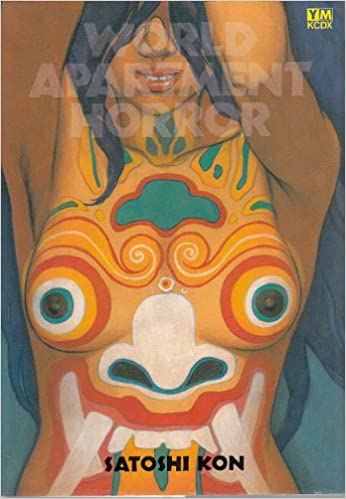
この作品は大友克洋により、実写の映画作品となる→ 「大友克洋の実写初監督作品。アジア系労働者が住む、とあるボロアパートを舞台に、地上げのために住み込んだチンピラ青年と住人たちとのやり取りを奇怪な 霊現象を交えコミカルに描いた風刺コメディ。外国人労働者たちが住みつくアパート南海荘。ヤクザの一太は地上げのため、このアパートに引っ越してくる。そ してアパートの住人に嫌がらせをするが、彼らは一向に立ち去らない。やがて一太は奇怪な現象に悩まされていく……」https://movies.yahoo.co.jp/movie/86720/story/. より
リンク
文献
その他の情報
-----------
For all undergraduate
students!!!, you do not paste but [re]think my message.
Remind Wittgenstein's phrase,
"I should not like my writing to spare other people the trouble of thinking. But, if possible, to stimulate someone to thoughts of his own," - Ludwig Wittgenstein
Copyleft, CC, Mitzub'ixi Quq Chi'j, 1996-2099

++
Copyleft,
CC, Mitzub'ixi Quq Chi'j, 1996-2099